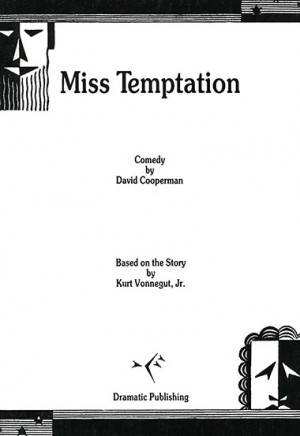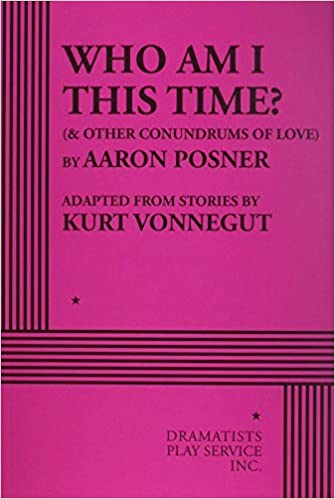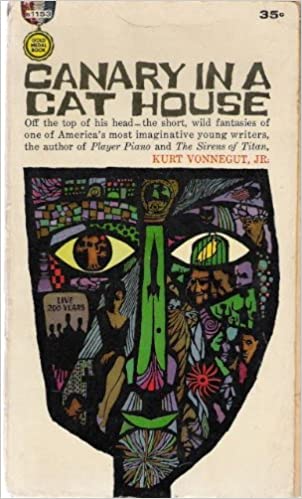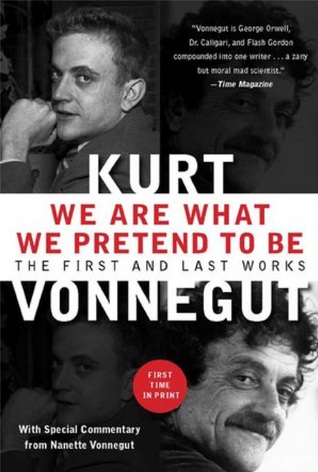Here is the complete list of books published by Kurt Vonnegut, a well-known American writer.
During his time, Kurt Vonnegut published five works of nonfiction, five plays, three short story collections, and fourteen novels.
Who Is Kurt Vonnegut?
Born on November 11, 1922, in Indianapolis, Indiana, Kurt Vonnegut dropped out of Cornell University to enlist in the US Army.
The army sent him to study in engineering, and the next year, he was deployed in Europe and fought in the Battle of the Bulge.
Vonnegut became a prisoner of war. And while in Dresden, Germany, he witnessed the Allied firebombing of the city. He, along with other POWs, was only able to escape harm because they were working in an underground meat locker.
Vonnegut soon returned home from the war and married his high school girlfriend, Jane Marie Cox. The couple had three children, and Vonnegut also adopted his sister’s children after her death in 1958.
Before embarking on a writing career, Vonnegut worked several odd jobs such as a teacher, a newspaper reporter, and a public relations employee for General Electric. His first novel, Player Piano, was published in 1952. It’s the first time people noticed the writer’s talent for satire, and more novels followed soon after that.
Vonnegut is known as one of the most influential American novelists of the 20th century. His works usually depict humor mixed with science fiction and literature.
War is also a common element in his work, and one of his most famous novels, Slaughterhouse-Five, draws some of its power from the writer’s own experiences during the war. The book’s main character, Billy Pilgrim, is also a soldier who became a prisoner of war.
Vonnegut’s humanist point of view and unusual writing style, consisting of long sentences and little punctuation, soon became a catalyst for him to become a new literary voice.
He continued writing novels and short stories, such as Deadeye Dick, Jailbird, and Breakfast of Champions. He soon gained a massive following and became a literary icon, but Vonnegut wrestled with some mental health issues despite his success. Vonnegut published his last novel, Timequake, in 1997. He died on April 11, 2007, at the age of 84. He was survived by his second wife, photographer Jill Krementz, their adopted daughter, Lily, and six children from his first marriage.
Kurt Vonnegut Complete Booklist & Summary
Here is the list of Kurt Vonnegut’s books along with a short summary:
1) Report on the Barnhouse Effect – 1950
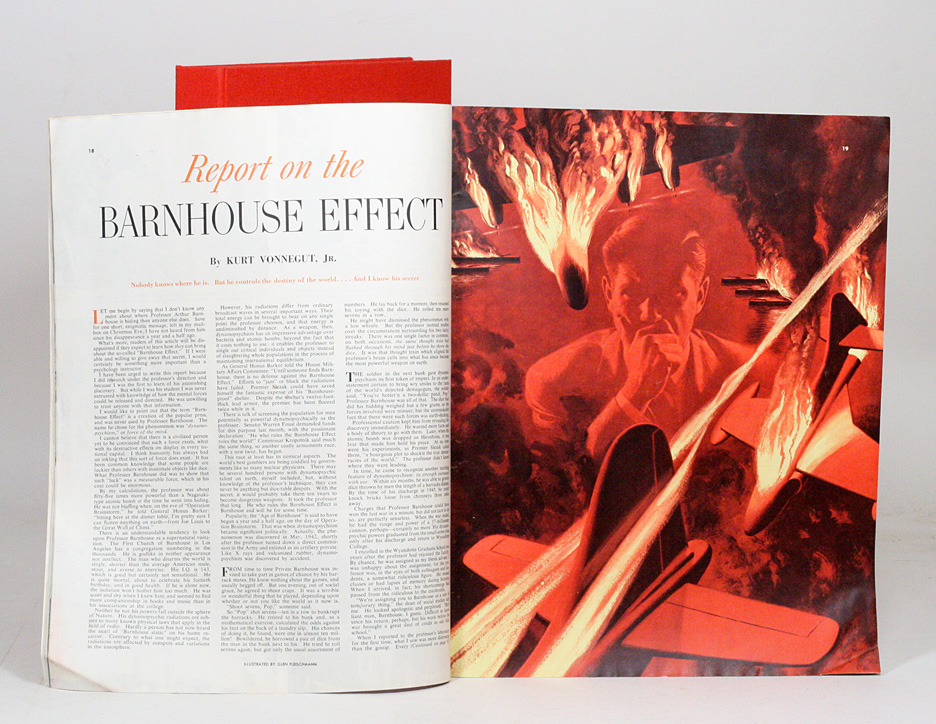 Book Summary: A professor discovers the secret of mind over matter – then struggles to keep his power out of the hands of the military. Based on a Kurt Vonnegut story, this episode of Dimension X originally aired on April 22, 1950.Featuring “adventures in time and space told in future tense”, Dimension X aired over NBC from April 8, 1950, through September 29, 1951. The series adapted stories by the modern masters of science fiction, including Ray Bradbury, Robert Heinlein, Clifford Simak, Theodore Sturgeon, and many others.
Book Summary: A professor discovers the secret of mind over matter – then struggles to keep his power out of the hands of the military. Based on a Kurt Vonnegut story, this episode of Dimension X originally aired on April 22, 1950.Featuring “adventures in time and space told in future tense”, Dimension X aired over NBC from April 8, 1950, through September 29, 1951. The series adapted stories by the modern masters of science fiction, including Ray Bradbury, Robert Heinlein, Clifford Simak, Theodore Sturgeon, and many others.- Book Reviews:
2) Player Piano – 1952 (First on Kurt Vonnegut’s Best Book List)
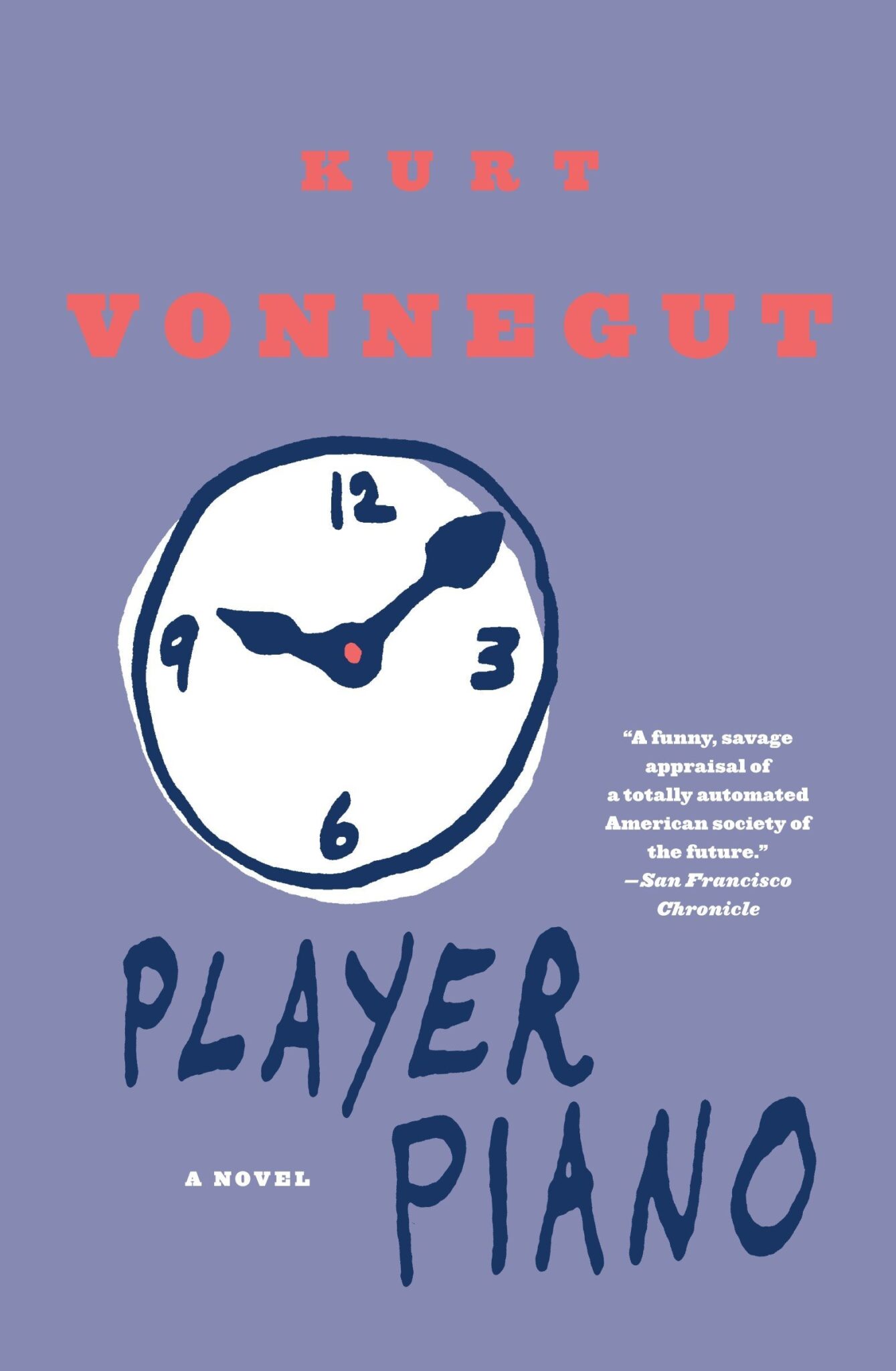 Book Summary: “A funny, savage appraisal of a totally automated American society of the future.”—San Francisco Chronicle
Book Summary: “A funny, savage appraisal of a totally automated American society of the future.”—San Francisco Chronicle
Kurt Vonnegut’s first novel spins the chilling tale of engineer Paul Proteus, who must find a way to live in a world dominated by a supercomputer and run completely by machines. Paul’s rebellion is vintage Vonnegut—wildly funny, deadly serious, and terrifyingly close to reality.Praise for Player Piano“An exuberant, crackling style . . . Vonnegut is a black humorist, fantasist and satirist, a man disposed to deep and comic reflection on the human dilemma.”—Life“His black logic . . . gives us something to laugh about and much to fear.”—The New York Times Book Review
- Book Reviews:
3) Miss Temptation – 1956
4) The Sirens of Titan – 1959 (Second on Kurt Vonnegut’s Best Book List)
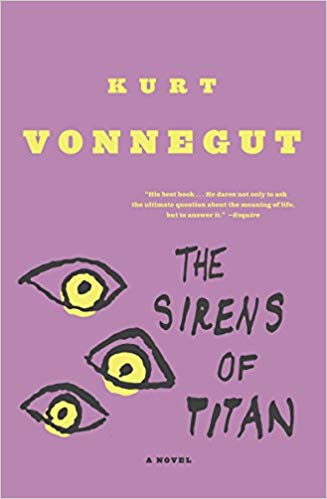 Book Summary: “[Kurt Vonnegut’s] best book . . . He dares not only ask the ultimate question about the meaning of life, but to answer it.”—Esquire
Book Summary: “[Kurt Vonnegut’s] best book . . . He dares not only ask the ultimate question about the meaning of life, but to answer it.”—Esquire
Nominated as one of America’s best-loved novels by PBS’s The Great American Read The Sirens of Titanis an outrageous romp through space, time, and morality. The richest, most depraved man on Earth, Malachi Constant, is offered a chance to take a space journey to distant worlds with a beautiful woman at his side. Of course there’ s a catch to the invitation–and a prophetic vision about the purpose of human life that only Vonnegut has the courage to tell.“Reading Vonnegut is addictive!”—Commonweal
- Book Reviews:
5) Who Am I This Time? – 1961
- Book Reviews:
6) Mother Night – 1961 (Third on Kurt Vonnegut’s Best Book List)
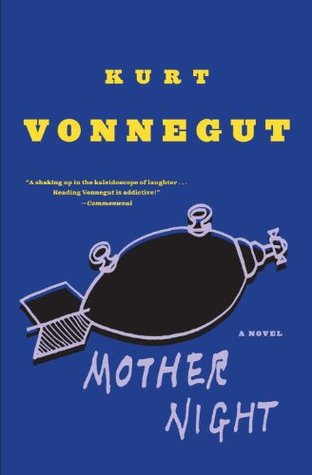 Book Summary: “Vonnegut is George Orwell, Dr. Caligari and Flash Gordon compounded into one writer . . . a zany but moral mad scientist.”—Time
Book Summary: “Vonnegut is George Orwell, Dr. Caligari and Flash Gordon compounded into one writer . . . a zany but moral mad scientist.”—Time
Mother Night is a daring challenge to our moral sense. American Howard W. Campbell, Jr., a spy during World War II, is now on trial in Israel as a Nazi war criminal. But is he really guilty? In this brilliant book rife with true gallows humor, Vonnegut turns black and white into a chilling shade of gray with a verdict that will haunt us all.“A great artist.”—Cincinnati Enquirer “A shaking up in the kaleidoscope of laughter . . . Reading Vonnegut is addictive!”—Commonweal
- Book Reviews:
7) Canary in a Cat House – 1961
- Book Reviews:
8) Harrison Bergeron – 1961
 Book Summary: It is the year 2081. Because of Amendments 211, 212, and 213 to the Constitution, every American is fully equal, meaning that no one is stupider, uglier, weaker, or slower than anyone else. The Handicapper General and a team of agents ensure that the laws of equality are enforced. One April, fourteen-year-old Harrison Bergeron is taken away from his parents, George and Hazel, by the government.
Book Summary: It is the year 2081. Because of Amendments 211, 212, and 213 to the Constitution, every American is fully equal, meaning that no one is stupider, uglier, weaker, or slower than anyone else. The Handicapper General and a team of agents ensure that the laws of equality are enforced. One April, fourteen-year-old Harrison Bergeron is taken away from his parents, George and Hazel, by the government.
- Book Reviews:
9) 2 B R 0 2 B – 1962
 Book Summary: This book was converted from its physical edition to the digital format by a community of volunteers. You may find it for free on the web. Purchase of the Kindle edition includes wireless delivery.
Book Summary: This book was converted from its physical edition to the digital format by a community of volunteers. You may find it for free on the web. Purchase of the Kindle edition includes wireless delivery.
- Book Reviews:
10) Cat’s Cradle – 1963 (Fourth on Kurt Vonnegut’s Best Book List)
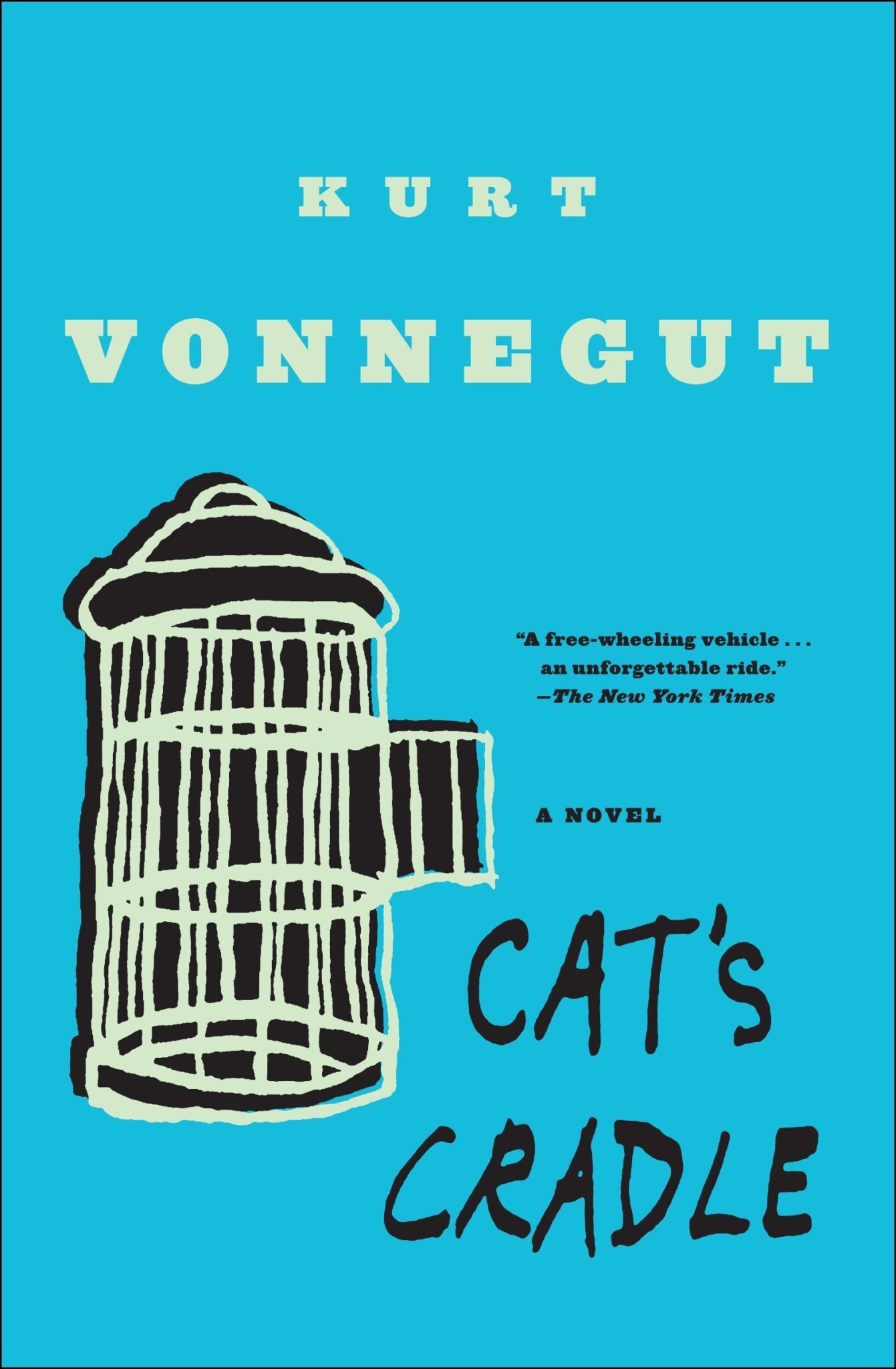 Book Summary: “A free-wheeling vehicle . . . an unforgettable ride!”—The New York Times
Book Summary: “A free-wheeling vehicle . . . an unforgettable ride!”—The New York Times
Cat’s Cradle is Kurt Vonnegut’s satirical commentary on modern man and his madness. An apocalyptic tale of this planet’s ultimate fate, it features a midget as the protagonist, a complete, original theology created by a calypso singer, and a vision of the future that is at once blackly fatalistic and hilariously funny. A book that left an indelible mark on an entire generation of readers, Cat’s Cradle is one of the twentieth century’s most important works—and Vonnegut at his very best.“[Vonnegut is] an unimitative and inimitable social satirist.”—Harper’s Magazine
“Our finest black-humorist . . . We laugh in self-defense.”—Atlantic Monthly
- Book Reviews:
11) All the King’s Horses – 1968
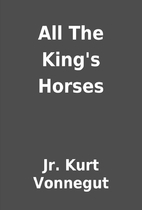 Book Summary: First published in Collier’s (1951-02-10)
Book Summary: First published in Collier’s (1951-02-10)
The story takes place in the early years of the Cold War and centers on U.S. Army Colonel Bryan Kelly, whose plane has crash-landed on the Asiatic mainland. With him are his two sons, his wife, the pilot and co-pilot, and ten enlisted men. The sixteen prisoners are held captive by the Communist guerrilla chief Pi Ying, who forces Kelly to play a game of chess using his family and men as the white pieces, and himself as the king. Any American pieces that Pi Ying captures will be executed immediately; if Kelly wins, he and his surviving pieces will be freed. A Russian military officer, Major Barzov, and Pi Ying’s female companion are present to watch the game.
- Book Reviews:
12) Welcome to the Monkey House – 1968
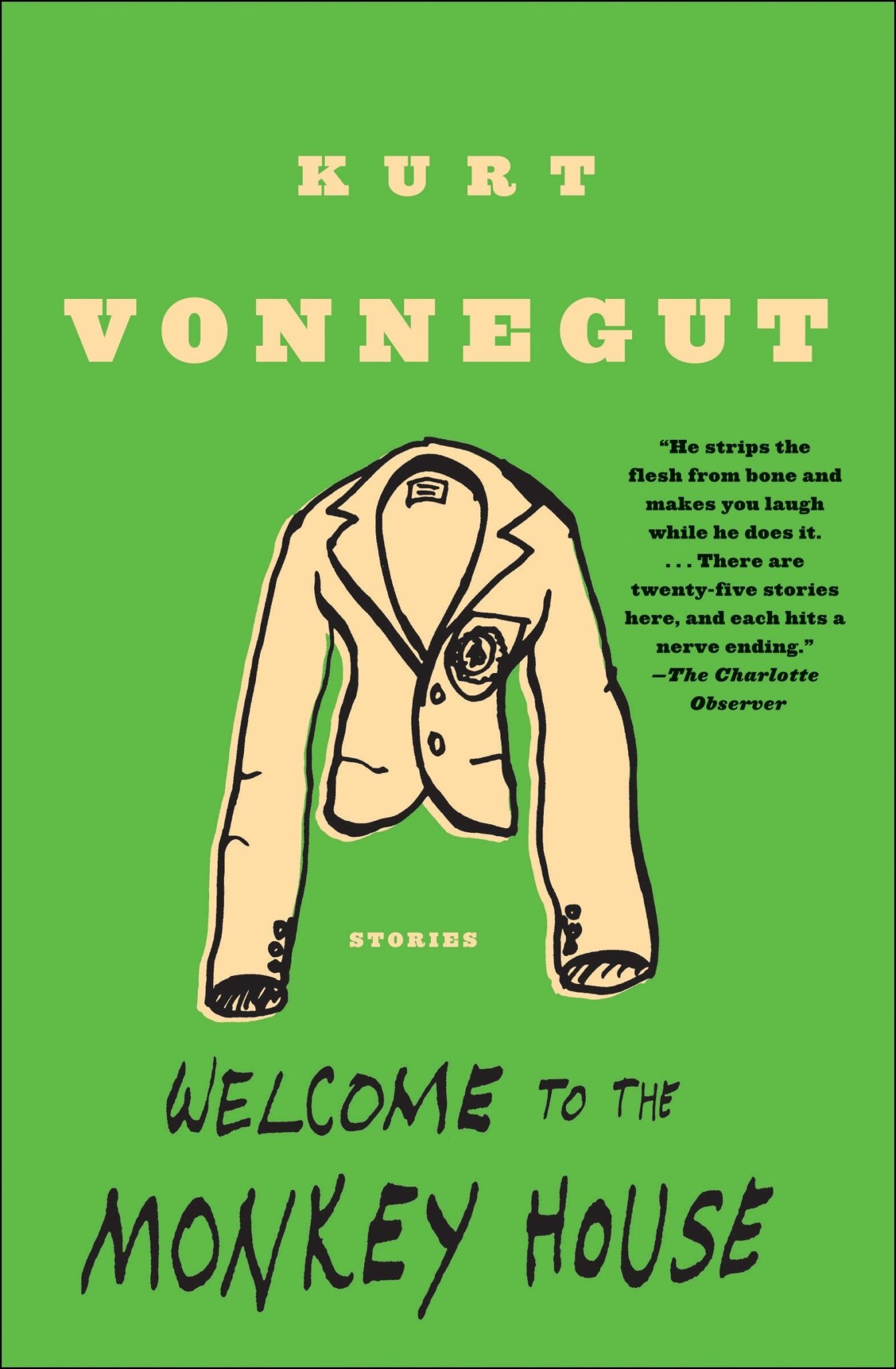 Book Summary: “[Kurt Vonnegut] strips the flesh from bone and makes you laugh while he does it. . . . There are twenty-five stories here, and each hits a nerve ending.”—The Charlotte ObserverWelcome to the Monkey House is a collection of Kurt Vonnegut’s shorter works. Originally printed in publications as diverse as The Magazine of Fantasy and Science Fiction and The Atlantic Monthly, these superb stories share Vonnegut’s audacious sense of humor and extraordinary range of creative vision. Includes the following stories:“Where I Live”
Book Summary: “[Kurt Vonnegut] strips the flesh from bone and makes you laugh while he does it. . . . There are twenty-five stories here, and each hits a nerve ending.”—The Charlotte ObserverWelcome to the Monkey House is a collection of Kurt Vonnegut’s shorter works. Originally printed in publications as diverse as The Magazine of Fantasy and Science Fiction and The Atlantic Monthly, these superb stories share Vonnegut’s audacious sense of humor and extraordinary range of creative vision. Includes the following stories:“Where I Live”
“Harrison Bergeron”
“Who Am I This Time?”
“Welcome to the Monkey House”
“Long Walk to Forever”
“The Foster Portfolio”
“Miss Temptation”
“All the King’s Horses”
“Tom Edison’s Shaggy Dog”
“New Dictionary”
“Next Door”
“More Stately Mansions”
“The Hyannis Port Story”
“D.P.”
“Report on the Barnhouse Effect”
“The Euphio Question”
“Go Back to Your Precious Wife and Son”
“Deer in the Works”
“The Lie”
“Unready to Wear”
“The Kid Nobody Could Handle”
“The Manned Missiles”
“Epicac”
“Adam”
“Tomorrow and Tomorrow and Tomorrow”
- Book Reviews:
13) Slaughterhouse-Five – 1969 (Fifth on Kurt Vonnegut’s Best Book List)
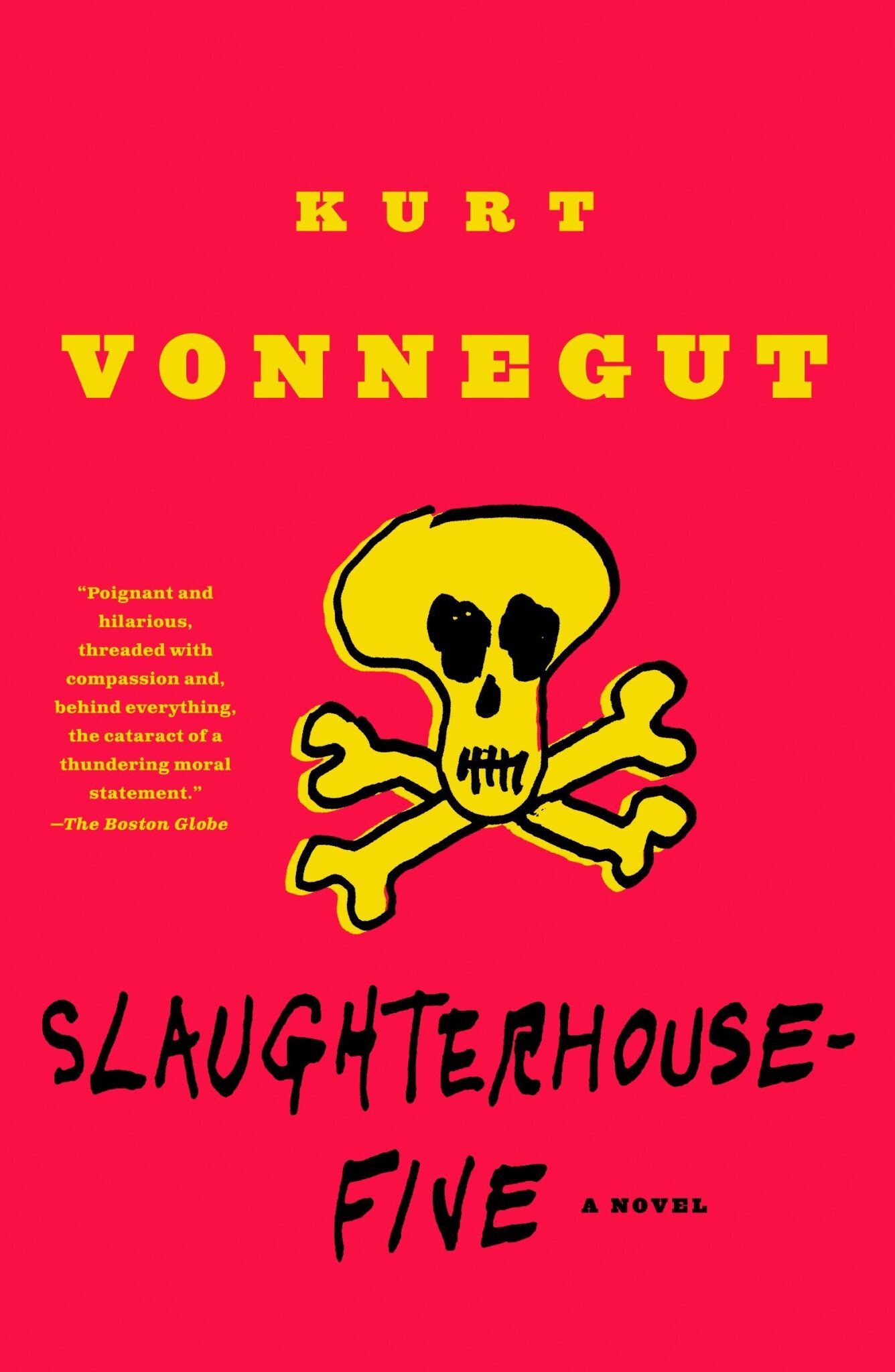 Book Summary: Slaughterhouse-Five, an American classic, is one of the world’s great antiwar books. Centering on the infamous firebombing of Dresden, Billy Pilgrim’s odyssey through time reflects the mythic journey of our own fractured lives as we search for meaning in what we fear most.
Book Summary: Slaughterhouse-Five, an American classic, is one of the world’s great antiwar books. Centering on the infamous firebombing of Dresden, Billy Pilgrim’s odyssey through time reflects the mythic journey of our own fractured lives as we search for meaning in what we fear most.
- Book Reviews:
14) Between Time and Timbuktu or Prometheus-5 – 1972
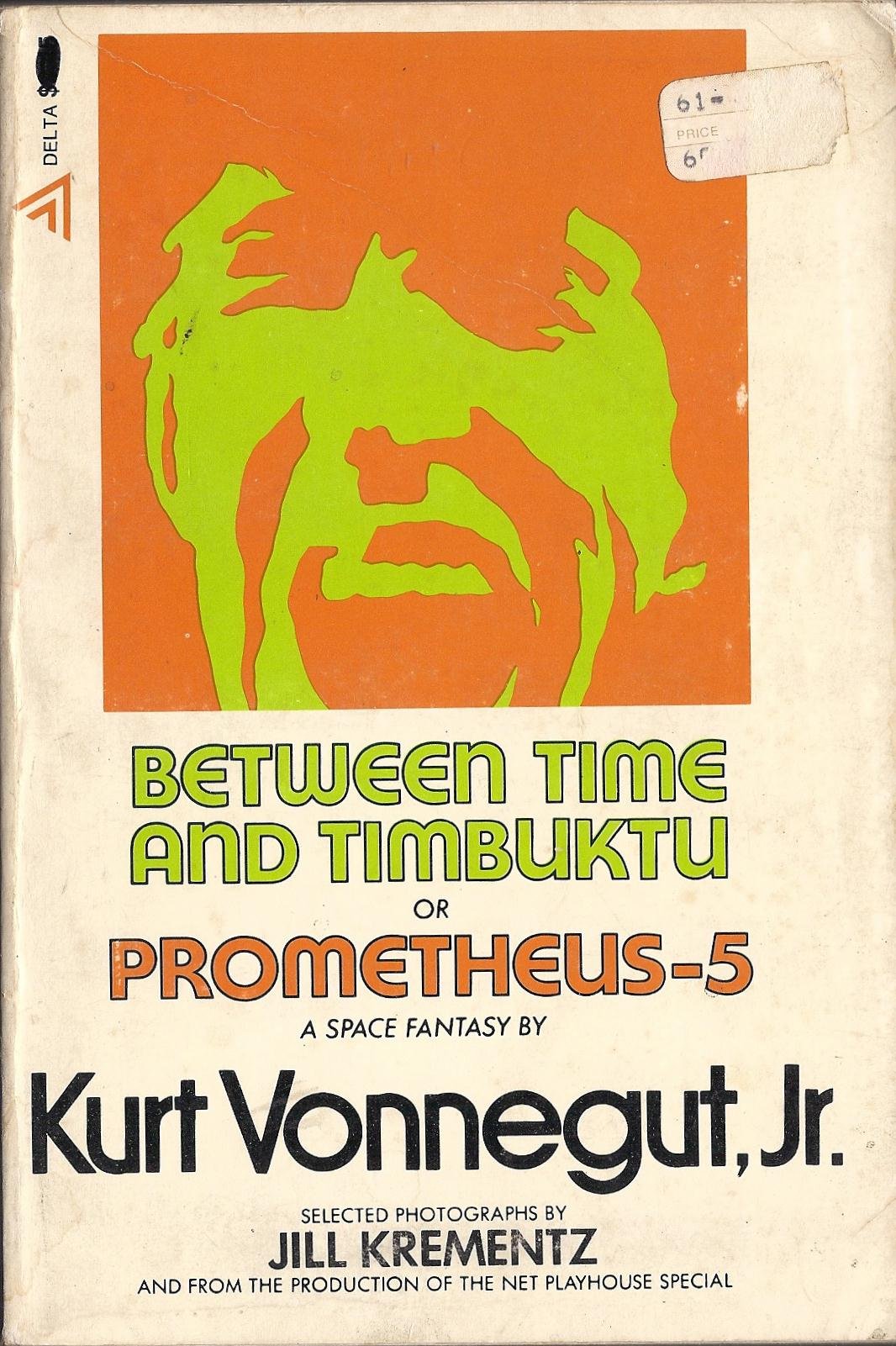 Book Summary: Low price due to light shelf wear. Never read. Fast shipping. We will make you happy or we will refund ALL your money with no hassles. Thanks in advance for your business. C-5
Book Summary: Low price due to light shelf wear. Never read. Fast shipping. We will make you happy or we will refund ALL your money with no hassles. Thanks in advance for your business. C-5
- Book Reviews:
15) Breakfast of Champions – 1973 (Sixth on Kurt Vonnegut’s Best Book List)
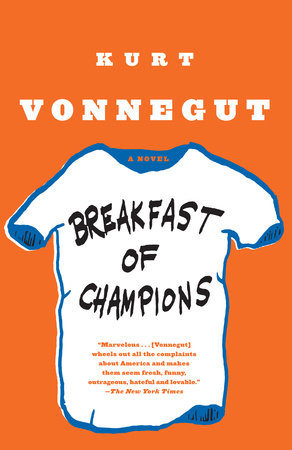 Book Summary: “Marvelous . . . [Vonnegut] wheels out all the complaints about America and makes them seem fresh, funny, outrageous, hateful and lovable.”—The New York Times In Breakfast of Champions, one of Kurt Vonnegut’s most beloved characters, the aging writer Kilgore Trout, finds to his horror that a Midwest car dealer is taking his fiction as truth. What follows is murderously funny satire, as Vonnegut looks at war, sex, racism, success, politics, and pollution in America and reminds us how to see the truth.“Free-wheeling, wild and great . . . uniquely Vonnegut.”—Publishers Weekly
Book Summary: “Marvelous . . . [Vonnegut] wheels out all the complaints about America and makes them seem fresh, funny, outrageous, hateful and lovable.”—The New York Times In Breakfast of Champions, one of Kurt Vonnegut’s most beloved characters, the aging writer Kilgore Trout, finds to his horror that a Midwest car dealer is taking his fiction as truth. What follows is murderously funny satire, as Vonnegut looks at war, sex, racism, success, politics, and pollution in America and reminds us how to see the truth.“Free-wheeling, wild and great . . . uniquely Vonnegut.”—Publishers Weekly
- Book Reviews:
16) Wampeters, Foma and Granfalloons – 1974
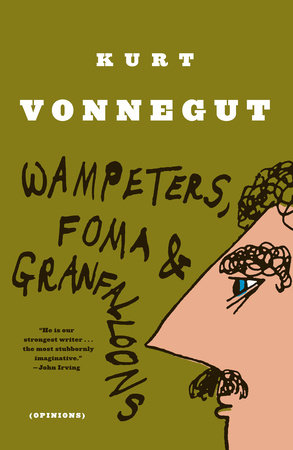 Book Summary: Wampeters, Foma & Granfalloons is a rare opportunity to experience Kurt Vonnegut speaking in his own voice about his own life, his views of the world, his writing, and the writing of others. An indignant, outrageous, witty, deeply felt collection of reviews, essays, and speeches, this is a window not only into Vonnegut’s mind but also into his heart.“A book filled with madness and truth and absurdity and self-revelation . . . [Vonnegut is] a great cosmic comedian and rattler of human skeletons, an idealist disguised as a pessimist.”—St. Louis Post-DispatchIncludes the following essays, speeches, and works:“Science Fiction”
Book Summary: Wampeters, Foma & Granfalloons is a rare opportunity to experience Kurt Vonnegut speaking in his own voice about his own life, his views of the world, his writing, and the writing of others. An indignant, outrageous, witty, deeply felt collection of reviews, essays, and speeches, this is a window not only into Vonnegut’s mind but also into his heart.“A book filled with madness and truth and absurdity and self-revelation . . . [Vonnegut is] a great cosmic comedian and rattler of human skeletons, an idealist disguised as a pessimist.”—St. Louis Post-DispatchIncludes the following essays, speeches, and works:“Science Fiction”
“Brief Encounters on the Inland Waterway”
“Hello, Star Vega”
“Teaching the Unteachable”
“Yes, We Have No Nirvanas”
“Fortitude”
“‘There’s a Maniac Loose Out There’”
“Excelsior! We’re Going to the Moon! Excelsior!”
“Address to the American Physical Society”
“Good Missiles, Good Manners, Good Night”
“Why They Read Hesse”
“Oversexed in Indianapolis”
“The Mysterious Madame Blavatsky”
“Biafra: A People Betrayed”
“Address to Graduating Class at Bennington College, 1970”
“Torture and Blubber”
“Address to the National Institute of Arts and Letters, 1971”
“Reflections on my Own Death”
“In a Manner that Must Shame God Himself”
“Thinking Unthinkable, Speaking Unspeakable”
“Address at Rededication of Wheaton College Library, 1973”
“Invite Rita Rait to America!”
“Address to P.E.N. Conference in Stockholm, 1973”
“A Political Disease”
“Playboy Interview”
- Book Reviews:
17) Slapstick – 1976
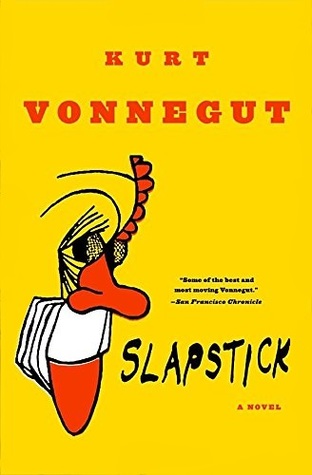 Book Summary: “Some of the best and most moving Vonnegut.”—San Francisco Chronicle Slapstick presents an apocalyptic vision as seen through the eyes of the current King of Manhattan (and last President of the United States), a wickedly irreverent look at the all-too-possible results of today’s follies. But even the end of life-as-we-know-it is transformed by Kurt Vonnegut’s pen into hilarious farce—a final slapstick that may be the Almighty’s joke on us all.“Both funny and sad . . . just about perfect.”—Los Angeles Times“Imaginative and hilarious . . . a brilliant vision of our wrecked, wacked-out future.”—Hartford Courant
Book Summary: “Some of the best and most moving Vonnegut.”—San Francisco Chronicle Slapstick presents an apocalyptic vision as seen through the eyes of the current King of Manhattan (and last President of the United States), a wickedly irreverent look at the all-too-possible results of today’s follies. But even the end of life-as-we-know-it is transformed by Kurt Vonnegut’s pen into hilarious farce—a final slapstick that may be the Almighty’s joke on us all.“Both funny and sad . . . just about perfect.”—Los Angeles Times“Imaginative and hilarious . . . a brilliant vision of our wrecked, wacked-out future.”—Hartford Courant
- Book Reviews:
18) Kurt Vonnegut: The Last Interview: And Other Conversations – 1977
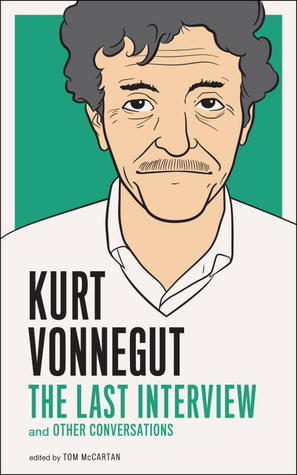 Book Summary: One of the great American iconoclasts holds forth on politics, war, books and writers, and his personal life in a series of conversations—including his last published interview.
Book Summary: One of the great American iconoclasts holds forth on politics, war, books and writers, and his personal life in a series of conversations—including his last published interview.
During his long career Kurt Vonnegut won international praise for his novels, plays, and essays. In this new anthology of conversations with Vonnegut—which collects interviews from throughout his career—we learn much about what drove Vonnegut to write and how he viewed his work at the end. From Kurt Vonnegut’s Last InterviewIs there another book in you, by chance? No. Look, I’m 84 years old. Writers of fiction have usually done their best work by the time they’re 45. Chess masters are through when they’re 35, and so are baseball players. There are plenty of other people writing. Let them do it.So what’s the old man’s game, then? My country is in ruins. So I’m a fish in a poisoned fishbowl. I’m mostly just heartsick about this. There should have been hope. This should have been a great country. But we are despised all over the world now. I was hoping to build a country and add to its literature. That’s why I served in World War II, and that’s why I wrote books. When someone reads one of your books, what would you like them to take from the experience?Well, I’d like the guy—or the girl, of course—to put the book down and think, “This is the greatest man who ever lived.”
- Book Reviews:
19) Jailbird – 1979 (Seventh on Kurt Vonnegut’s Best Book List)
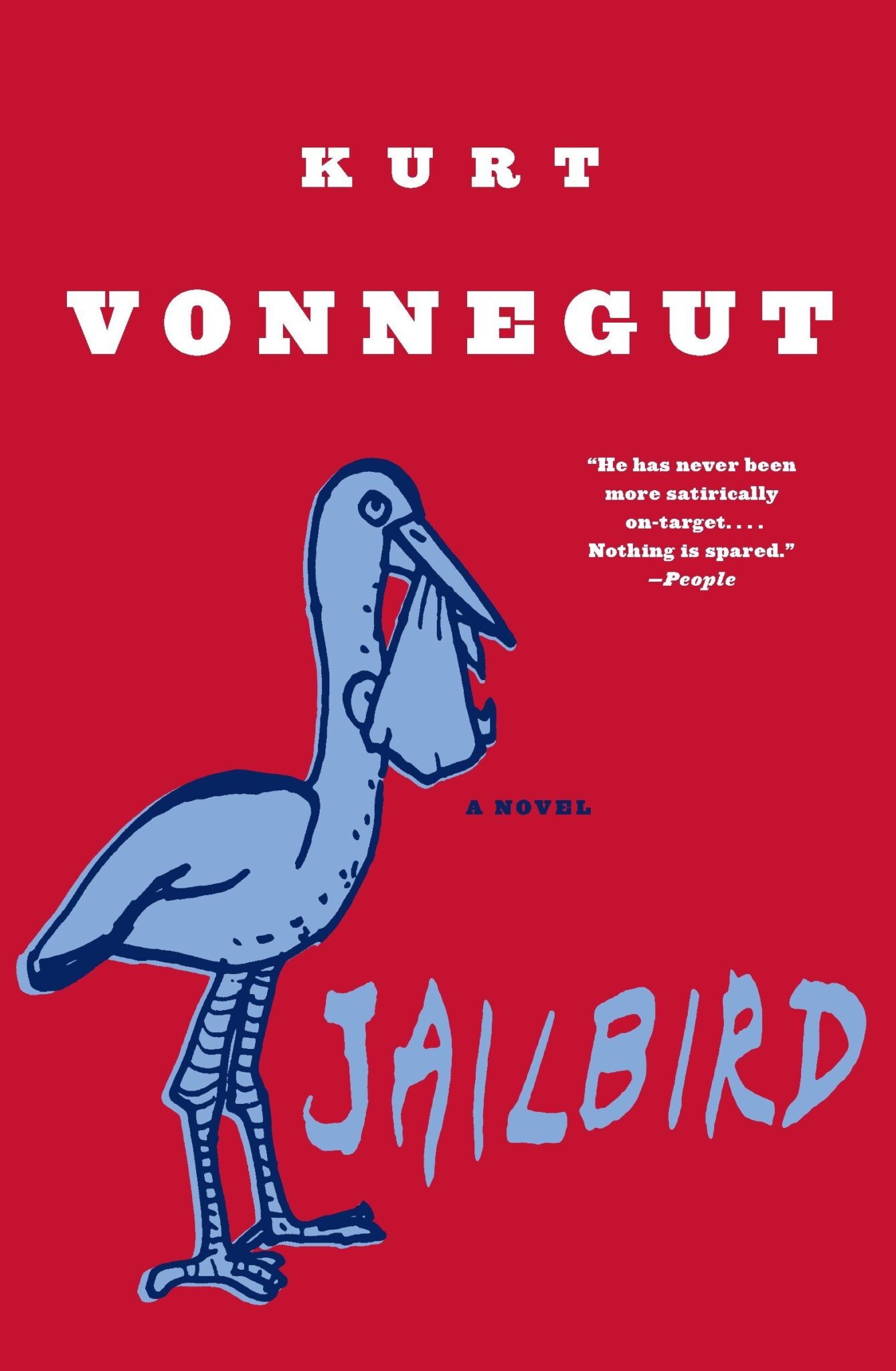 Book Summary: “[Kurt Vonnegut] has never been more satirically on-target. . . . Nothing is spared.”—PeopleJailbirdtakes us into a fractured and comic, pure Vonnegut world of high crimes and misdemeanors in government—and in the heart. This wry tale follows bumbling bureaucrat Walter F. Starbuck from Harvard to the Nixon White House to the penitentiary as Watergate’s least known co-conspirator. But the humor turns dark when Vonnegut shines his spotlight on the cold hearts and calculated greed of the mighty, giving a razor-sharp edge to an unforgettable portrait of power and politics in our times.Praise for Jailbird“[Vonnegut] is our strongest writer . . . the most stubbornly imaginative.”—John Irving“A gem . . . a mature, imaginative novel—possibly the best he has written . . . Jailbird is a guided tour de force of America. Take it!”—Playboy“A profoundly humane comedy . . . Jailbird definitely mounts up on angelic wings—in its speed, in its sparkle, and in its high-flying intent.”—Chicago Tribune Book World“Joyously inventive . . . gleams with the loony magic Vonnegut alone can achieve.”—Cosmopolitan“Vonnegut is our great apocalyptic writer, the closest thing we’ve had to a prophet since . . . Lenny Bruce.”—Chicago Sun-Times“Vonnegut at his impressive best. . . . His imaginative leaps alone . . . are worth the price of admission. . . . His far-reaching metaphysical and cultural concerns . . . are ultimately serious and worth our contemplation.”—The Washington Post
Book Summary: “[Kurt Vonnegut] has never been more satirically on-target. . . . Nothing is spared.”—PeopleJailbirdtakes us into a fractured and comic, pure Vonnegut world of high crimes and misdemeanors in government—and in the heart. This wry tale follows bumbling bureaucrat Walter F. Starbuck from Harvard to the Nixon White House to the penitentiary as Watergate’s least known co-conspirator. But the humor turns dark when Vonnegut shines his spotlight on the cold hearts and calculated greed of the mighty, giving a razor-sharp edge to an unforgettable portrait of power and politics in our times.Praise for Jailbird“[Vonnegut] is our strongest writer . . . the most stubbornly imaginative.”—John Irving“A gem . . . a mature, imaginative novel—possibly the best he has written . . . Jailbird is a guided tour de force of America. Take it!”—Playboy“A profoundly humane comedy . . . Jailbird definitely mounts up on angelic wings—in its speed, in its sparkle, and in its high-flying intent.”—Chicago Tribune Book World“Joyously inventive . . . gleams with the loony magic Vonnegut alone can achieve.”—Cosmopolitan“Vonnegut is our great apocalyptic writer, the closest thing we’ve had to a prophet since . . . Lenny Bruce.”—Chicago Sun-Times“Vonnegut at his impressive best. . . . His imaginative leaps alone . . . are worth the price of admission. . . . His far-reaching metaphysical and cultural concerns . . . are ultimately serious and worth our contemplation.”—The Washington Post
- Book Reviews:
20) Sun, moon, star – 1980
 Book Summary: Sun Moon Star is the story of the birth of Jesus–as told by Kurt Vonnegut. This children’s book takes the newborn Jesus’ perspective, offering beautiful and insightful descriptions of the world from someone newly born into it. In this book, we follow Jesus and meet the people most important to his life–presented in new and surprising ways.A powerful departure from Vonnegut’s more adult work, Sun Moon Star gives readers a rare glimpse of the writer’s talent in a format that’s unique and unexpected. Originally published in 1980, the book is long out of print, but is available as an E-book.
Book Summary: Sun Moon Star is the story of the birth of Jesus–as told by Kurt Vonnegut. This children’s book takes the newborn Jesus’ perspective, offering beautiful and insightful descriptions of the world from someone newly born into it. In this book, we follow Jesus and meet the people most important to his life–presented in new and surprising ways.A powerful departure from Vonnegut’s more adult work, Sun Moon Star gives readers a rare glimpse of the writer’s talent in a format that’s unique and unexpected. Originally published in 1980, the book is long out of print, but is available as an E-book.
- Book Reviews:
21) Palm Sunday – 1981
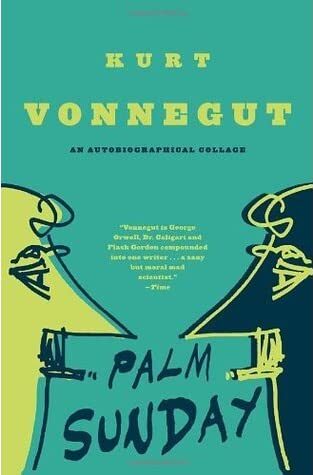 Book Summary: “[Kurt Vonnegut] is either the funniest serious writer around or the most serious funny writer.”—Los Angeles Times Book Review In this self-portrait by an American genius, Kurt Vonnegut writes with beguiling wit and poignant wisdom about his favorite comedians, country music, a dead friend, a dead marriage, and various cockamamie aspects of his all-too-human journey through life. This is a work that resonates with Vonnegut’s singular voice: the magic sound of a born storyteller mesmerizing us with truth.“Vonnegut is at the top of his form, and it is wonderful.”—Newsday
Book Summary: “[Kurt Vonnegut] is either the funniest serious writer around or the most serious funny writer.”—Los Angeles Times Book Review In this self-portrait by an American genius, Kurt Vonnegut writes with beguiling wit and poignant wisdom about his favorite comedians, country music, a dead friend, a dead marriage, and various cockamamie aspects of his all-too-human journey through life. This is a work that resonates with Vonnegut’s singular voice: the magic sound of a born storyteller mesmerizing us with truth.“Vonnegut is at the top of his form, and it is wonderful.”—Newsday
- Book Reviews:
22) Deadeye Dick – 1982
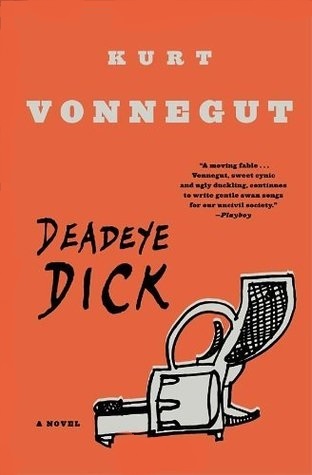 Book Summary: “The master at his quirky, provocative best.”—CosmopolitanDeadeye Dick is Kurt Vonnegut’s funny, chillingly satirical look at the death of innocence. Amid a true Vonnegutian host of horrors—a double murder, a fatal dose of radioactivity, a decapitation, an annihilation of a city by a neutron bomb—Rudy Waltz, aka Deadeye Dick, takes us along on a zany search for absolution and happiness. Here is a tale of crime and punishment that makes us rethink what we believe . . . and who we say we are.Praise for Deadeye Dick“A moving fable . . . Vonnegut, sweet cynic and ugly duckling, continues to write gentle swan songs for our uncivil society.”—Playboy “A brilliantly unconventional novel . . . a must for all Vonnegut fans.”—Worcester Sunday Telegram“Hits the bull’s-eye . . . dolefully celebrates the randomness of life, treating private and public disasters with a kind of reckless whimsy. . . . You don’t read Kurt Vonnegut for meaning exactly. You read him for the sad-funny attitude of mind, the kind of weirdness that can interpret the world’s weirdness.”—USA Today“Vonnegut is beguiling as ever . . . Incredible plot constructions and inventive language continue to leap from his typewriter . . . the humor is natural and inborn; the insight usually purchased by his characters at painfully high cost. Funny how life turns out. Even funnier how Mr. Vonnegut turns life’s insanities into funny, profound sense. That takes a master’s touch. Mr. Vonnegut still has it.”—Kansas City Star“Playful and imaginative . . . On finishing the novel, the kitchen of your mind is a cleaner and more well-lighted place than it was before.”—Houston Chronicle“Endearing and enchanting . . . a wise and charming book . . . very full of life.”—Glamour
Book Summary: “The master at his quirky, provocative best.”—CosmopolitanDeadeye Dick is Kurt Vonnegut’s funny, chillingly satirical look at the death of innocence. Amid a true Vonnegutian host of horrors—a double murder, a fatal dose of radioactivity, a decapitation, an annihilation of a city by a neutron bomb—Rudy Waltz, aka Deadeye Dick, takes us along on a zany search for absolution and happiness. Here is a tale of crime and punishment that makes us rethink what we believe . . . and who we say we are.Praise for Deadeye Dick“A moving fable . . . Vonnegut, sweet cynic and ugly duckling, continues to write gentle swan songs for our uncivil society.”—Playboy “A brilliantly unconventional novel . . . a must for all Vonnegut fans.”—Worcester Sunday Telegram“Hits the bull’s-eye . . . dolefully celebrates the randomness of life, treating private and public disasters with a kind of reckless whimsy. . . . You don’t read Kurt Vonnegut for meaning exactly. You read him for the sad-funny attitude of mind, the kind of weirdness that can interpret the world’s weirdness.”—USA Today“Vonnegut is beguiling as ever . . . Incredible plot constructions and inventive language continue to leap from his typewriter . . . the humor is natural and inborn; the insight usually purchased by his characters at painfully high cost. Funny how life turns out. Even funnier how Mr. Vonnegut turns life’s insanities into funny, profound sense. That takes a master’s touch. Mr. Vonnegut still has it.”—Kansas City Star“Playful and imaginative . . . On finishing the novel, the kitchen of your mind is a cleaner and more well-lighted place than it was before.”—Houston Chronicle“Endearing and enchanting . . . a wise and charming book . . . very full of life.”—Glamour
- Book Reviews:
23) Galápagos – 1985
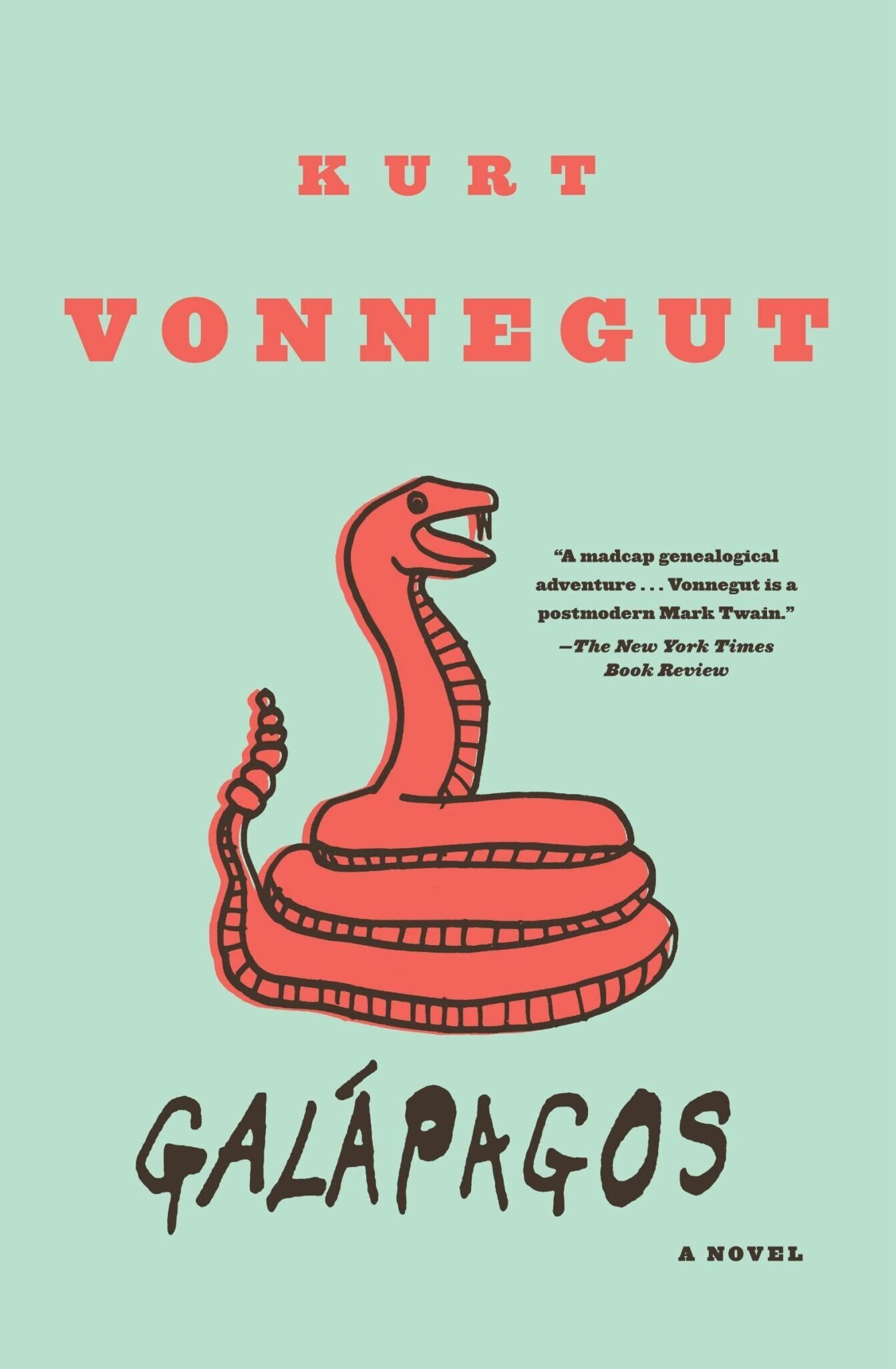 Book Summary: “A madcap genealogical adventure . . . Vonnegut is a postmodern Mark Twain.”—The New York Times Book ReviewGalápagos takes the reader back one million years, to A.D. 1986. A simple vacation cruise suddenly becomes an evolutionary journey. Thanks to an apocalypse, a small group of survivors stranded on the Galápagos Islands are about to become the progenitors of a brave, new, and totally different human race. In this inimitable novel, America’ s master satirist looks at our world and shows us all that is sadly, madly awry–and all that is worth saving.Praise for Galápagos“The best Vonnegut novel yet!”—John Irving“Beautiful . . . provocative, arresting reading.”—USA Today“A satire in the classic tradition . . . a dark vision, a heartfelt warning.”—The Detroit Free Press“Interesting, engaging, sad and yet very funny . . . Vonnegut is still in top form. If he has no prescription for alleviating the pain of the human condition, at least he is a first-rate diagnostician.”—Susan Isaacs, Newsday“Dark . . . original and funny.”—People“A triumph of style, originality and warped yet consistent logic . . . a condensation, an evolution of Vonnegut’s entire career, including all the issues and questions he has pursued relentlessly for four decades.”—The Philadelphia Inquirer“Wild details, wry humor, outrageous characters . . . Galápagos is a comic lament, a sadly ironic vison.”—St. Louis Post-Dispatch“A work of high comedy, sadness and imagination.”—The Denver Post“Wacky wit and irreverent imagination . . . and the full range of technical innovations have made [Vonnegut] America’s preeminent experimental novelist.”—The Minneapolis Star and Tribune
Book Summary: “A madcap genealogical adventure . . . Vonnegut is a postmodern Mark Twain.”—The New York Times Book ReviewGalápagos takes the reader back one million years, to A.D. 1986. A simple vacation cruise suddenly becomes an evolutionary journey. Thanks to an apocalypse, a small group of survivors stranded on the Galápagos Islands are about to become the progenitors of a brave, new, and totally different human race. In this inimitable novel, America’ s master satirist looks at our world and shows us all that is sadly, madly awry–and all that is worth saving.Praise for Galápagos“The best Vonnegut novel yet!”—John Irving“Beautiful . . . provocative, arresting reading.”—USA Today“A satire in the classic tradition . . . a dark vision, a heartfelt warning.”—The Detroit Free Press“Interesting, engaging, sad and yet very funny . . . Vonnegut is still in top form. If he has no prescription for alleviating the pain of the human condition, at least he is a first-rate diagnostician.”—Susan Isaacs, Newsday“Dark . . . original and funny.”—People“A triumph of style, originality and warped yet consistent logic . . . a condensation, an evolution of Vonnegut’s entire career, including all the issues and questions he has pursued relentlessly for four decades.”—The Philadelphia Inquirer“Wild details, wry humor, outrageous characters . . . Galápagos is a comic lament, a sadly ironic vison.”—St. Louis Post-Dispatch“A work of high comedy, sadness and imagination.”—The Denver Post“Wacky wit and irreverent imagination . . . and the full range of technical innovations have made [Vonnegut] America’s preeminent experimental novelist.”—The Minneapolis Star and Tribune
- Book Reviews:
24) Bluebeard – 1987 (Eighth on Kurt Vonnegut’s Best Book List)
 Book Summary: “Ranks with Vonnegut’s best and goes one step beyond . . . joyous, soaring fiction.”—The Atlanta Journal and ConstitutionBroad humor and bitter irony collide in this fictional autobiography of Rabo Karabekian, who, at age seventy-one, wants to be left alone on his Long Island estate with the secret he has locked inside his potato barn. But then a voluptuous young widow badgers Rabo into telling his life story—and Vonnegut in turn tells us the plain, heart-hammering truth about man’s careless fancy to create or destroy what he loves.Praise for Bluebeard“Vonnegut is at his edifying best.”—The Philadelphia Inquirer“The quicksilver mind of Vonnegut is at it again. . . . He displays all his talents—satire, irony, ridicule, slapstick, and even a shaggy dog story of epic proportions.”—The Cincinnati Post“[Kurt Vonnegut is] a voice you can trust to keep poking holes in the social fabric.”—San Francisco Chronicle“It has the qualities of classic Bosch and Slaughterhouse Vonnegut. . . . Bluebeard is uncommonly feisty.”—USA Today“Is Bluebeard good? Yes! . . . This is vintage Vonnegut—good wine from his best grapes.”—The Detroit News“A joyride . . . Vonnegut is more fascinated and puzzled than angered by the human stupidities and contradictions he discerns so keenly. So hop in his rumble seat. As you whiz along, what you observe may provide some new perspectives.”—Kansas City Star
Book Summary: “Ranks with Vonnegut’s best and goes one step beyond . . . joyous, soaring fiction.”—The Atlanta Journal and ConstitutionBroad humor and bitter irony collide in this fictional autobiography of Rabo Karabekian, who, at age seventy-one, wants to be left alone on his Long Island estate with the secret he has locked inside his potato barn. But then a voluptuous young widow badgers Rabo into telling his life story—and Vonnegut in turn tells us the plain, heart-hammering truth about man’s careless fancy to create or destroy what he loves.Praise for Bluebeard“Vonnegut is at his edifying best.”—The Philadelphia Inquirer“The quicksilver mind of Vonnegut is at it again. . . . He displays all his talents—satire, irony, ridicule, slapstick, and even a shaggy dog story of epic proportions.”—The Cincinnati Post“[Kurt Vonnegut is] a voice you can trust to keep poking holes in the social fabric.”—San Francisco Chronicle“It has the qualities of classic Bosch and Slaughterhouse Vonnegut. . . . Bluebeard is uncommonly feisty.”—USA Today“Is Bluebeard good? Yes! . . . This is vintage Vonnegut—good wine from his best grapes.”—The Detroit News“A joyride . . . Vonnegut is more fascinated and puzzled than angered by the human stupidities and contradictions he discerns so keenly. So hop in his rumble seat. As you whiz along, what you observe may provide some new perspectives.”—Kansas City Star
- Book Reviews:
25) Conversations with Kurt Vonnegut – 1988
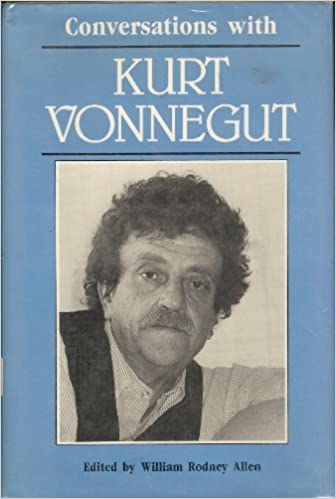 Book Summary: Kurt Vonnegut says: “I’ve worked with enough students to know what beginning writers are like, and if they will just talk to me for twenty minutes I can help them so much, because there are such simple things to know. Make a character want something-that’s how you begin.” William Rodney Allen teaches English at the Louisiana School for Math, Science, and the Arts. He is the author of “Walker Percy: The Southern Wayfarer.”
Book Summary: Kurt Vonnegut says: “I’ve worked with enough students to know what beginning writers are like, and if they will just talk to me for twenty minutes I can help them so much, because there are such simple things to know. Make a character want something-that’s how you begin.” William Rodney Allen teaches English at the Louisiana School for Math, Science, and the Arts. He is the author of “Walker Percy: The Southern Wayfarer.”
- Book Reviews:
26) Hocus Pocus – 1990
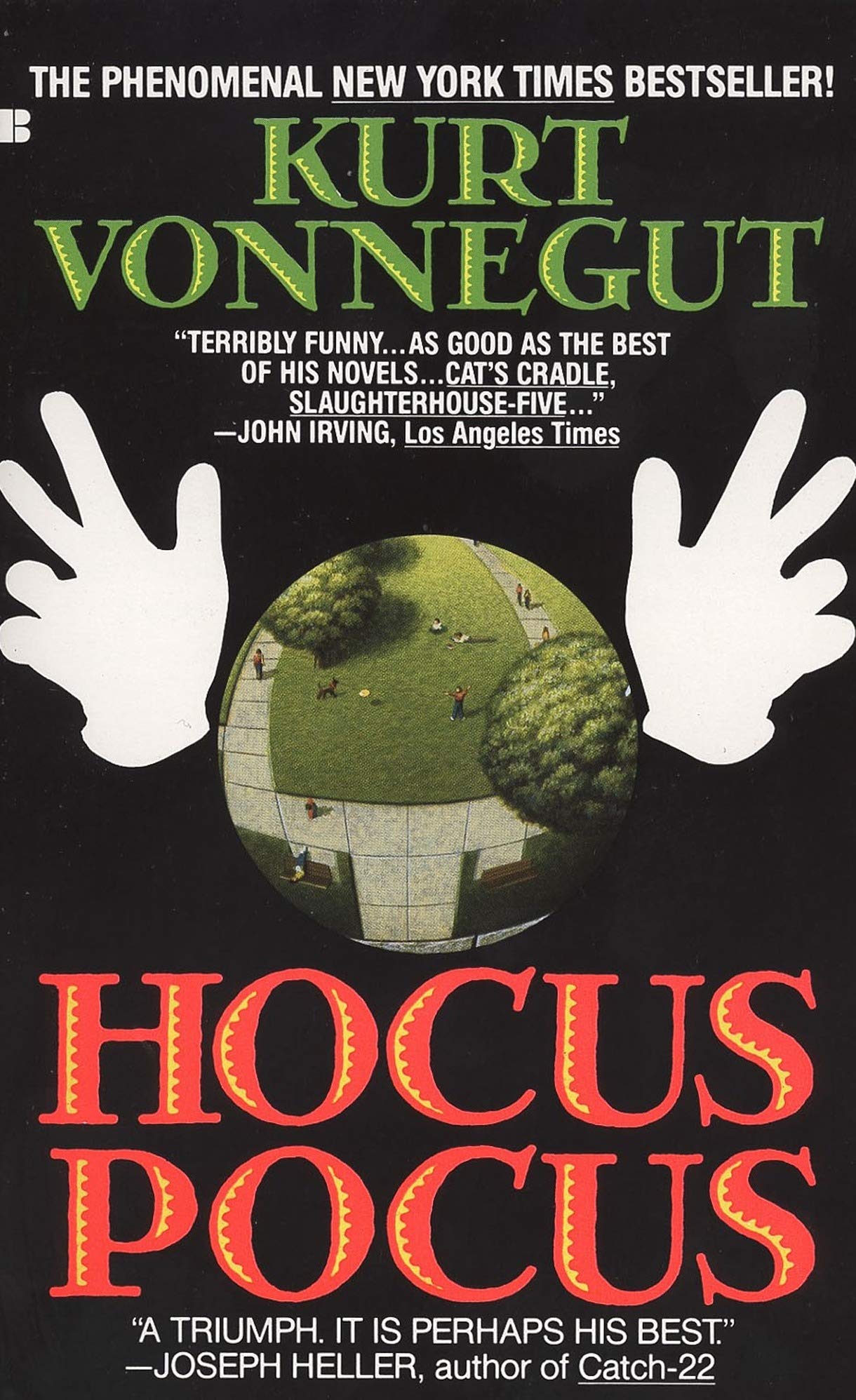 Book Summary: From the New York Times bestselling author of Slaughterhouse-Five comes an irresistible novel that combines “clever wit with keen social observation…[and] re-establishes Mr. Vonnegut’s place as the Mark Twain of our times” (Atlanta Journal & Constitution).Here is the adventure of Eugene Debs Hartke. He’s a Vietnam veteran, a jazz pianist, a college professor, and a prognosticator of the apocalypse (and other things Earth-shattering). But that’s neither here nor there. Because at Tarkington College—where he teaches—the excrement is about to hit the air-conditioning. And it’s all Eugene’s fault.
Book Summary: From the New York Times bestselling author of Slaughterhouse-Five comes an irresistible novel that combines “clever wit with keen social observation…[and] re-establishes Mr. Vonnegut’s place as the Mark Twain of our times” (Atlanta Journal & Constitution).Here is the adventure of Eugene Debs Hartke. He’s a Vietnam veteran, a jazz pianist, a college professor, and a prognosticator of the apocalypse (and other things Earth-shattering). But that’s neither here nor there. Because at Tarkington College—where he teaches—the excrement is about to hit the air-conditioning. And it’s all Eugene’s fault.
- Book Reviews:
27) Fates Worse Than Death – 1991
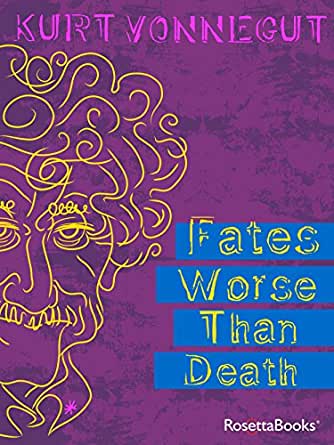 Book Summary: Kurt Vonnegut presents in Fates Worse than Death a veritable cornucopia of his thoughts on what could perhaps best be summed up as “anti-theology”, a manifesto for atheism that details Vonnegut’s drift from conventional religion, even a tract evidencing belief in the divine held within each individual self–the deity within each individual person present in a universe that otherwise lacks any real order. Vonnegut was never a real optimist, and with just cause: he had an incredibly difficult life (he had been a prisoner of war, from which he drew the title for his book Slaughterhouse-Five) and suffered from failing health, which only showed him his own mortality even more than he already knew it. Still, most readers find that in the body of Vonnegut’s work there is a glimmer of desperate hope. Vonnegut’s continued search for meaning surely counts for a great deal as he balances hope and despair. Scholars and fans can read about Vonnegut’s experiences during World War II and the after effect he felt it had on him. His religious (or antireligious) ramblings and notations are interesting and, by turns, funny and perceptive. The humor may be dark, but that does not make it any the less funny.
Book Summary: Kurt Vonnegut presents in Fates Worse than Death a veritable cornucopia of his thoughts on what could perhaps best be summed up as “anti-theology”, a manifesto for atheism that details Vonnegut’s drift from conventional religion, even a tract evidencing belief in the divine held within each individual self–the deity within each individual person present in a universe that otherwise lacks any real order. Vonnegut was never a real optimist, and with just cause: he had an incredibly difficult life (he had been a prisoner of war, from which he drew the title for his book Slaughterhouse-Five) and suffered from failing health, which only showed him his own mortality even more than he already knew it. Still, most readers find that in the body of Vonnegut’s work there is a glimmer of desperate hope. Vonnegut’s continued search for meaning surely counts for a great deal as he balances hope and despair. Scholars and fans can read about Vonnegut’s experiences during World War II and the after effect he felt it had on him. His religious (or antireligious) ramblings and notations are interesting and, by turns, funny and perceptive. The humor may be dark, but that does not make it any the less funny.
- Book Reviews:
28) Timequake – 1997
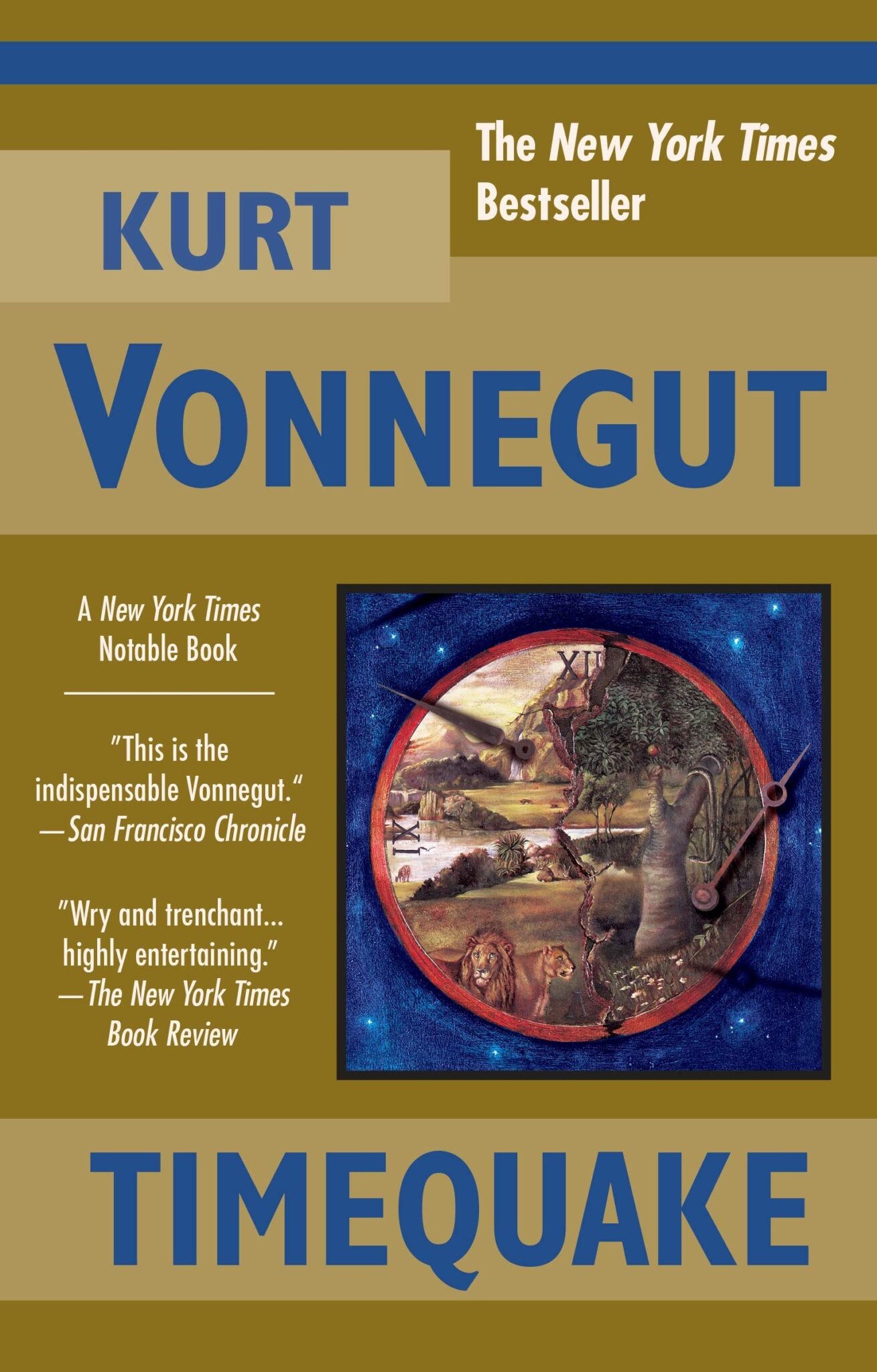 Book Summary: A New York Times Notable Book from the acclaimed author of Slaughterhouse-Five, Breakfast of Champions, and Cat’s Cradle.At 2:27pm on February 13th of the year 2001, the Universe suffered a crisis in self-confidence. Should it go on expanding indefinitely? What was the point?There’s been a timequake. And everyone—even you—must live the decade between February 17, 1991 and February 17, 2001 over again. The trick is that we all have to do exactly the same things as we did the first time—minute by minute, hour by hour, year by year, betting on the wrong horse again, marrying the wrong person again. Why? You’ll have to ask the old science fiction writer, Kilgore Trout. This was all his idea.
Book Summary: A New York Times Notable Book from the acclaimed author of Slaughterhouse-Five, Breakfast of Champions, and Cat’s Cradle.At 2:27pm on February 13th of the year 2001, the Universe suffered a crisis in self-confidence. Should it go on expanding indefinitely? What was the point?There’s been a timequake. And everyone—even you—must live the decade between February 17, 1991 and February 17, 2001 over again. The trick is that we all have to do exactly the same things as we did the first time—minute by minute, hour by hour, year by year, betting on the wrong horse again, marrying the wrong person again. Why? You’ll have to ask the old science fiction writer, Kilgore Trout. This was all his idea.
- Book Reviews:
29) God Bless You, Dr. Kevorkian – 1999
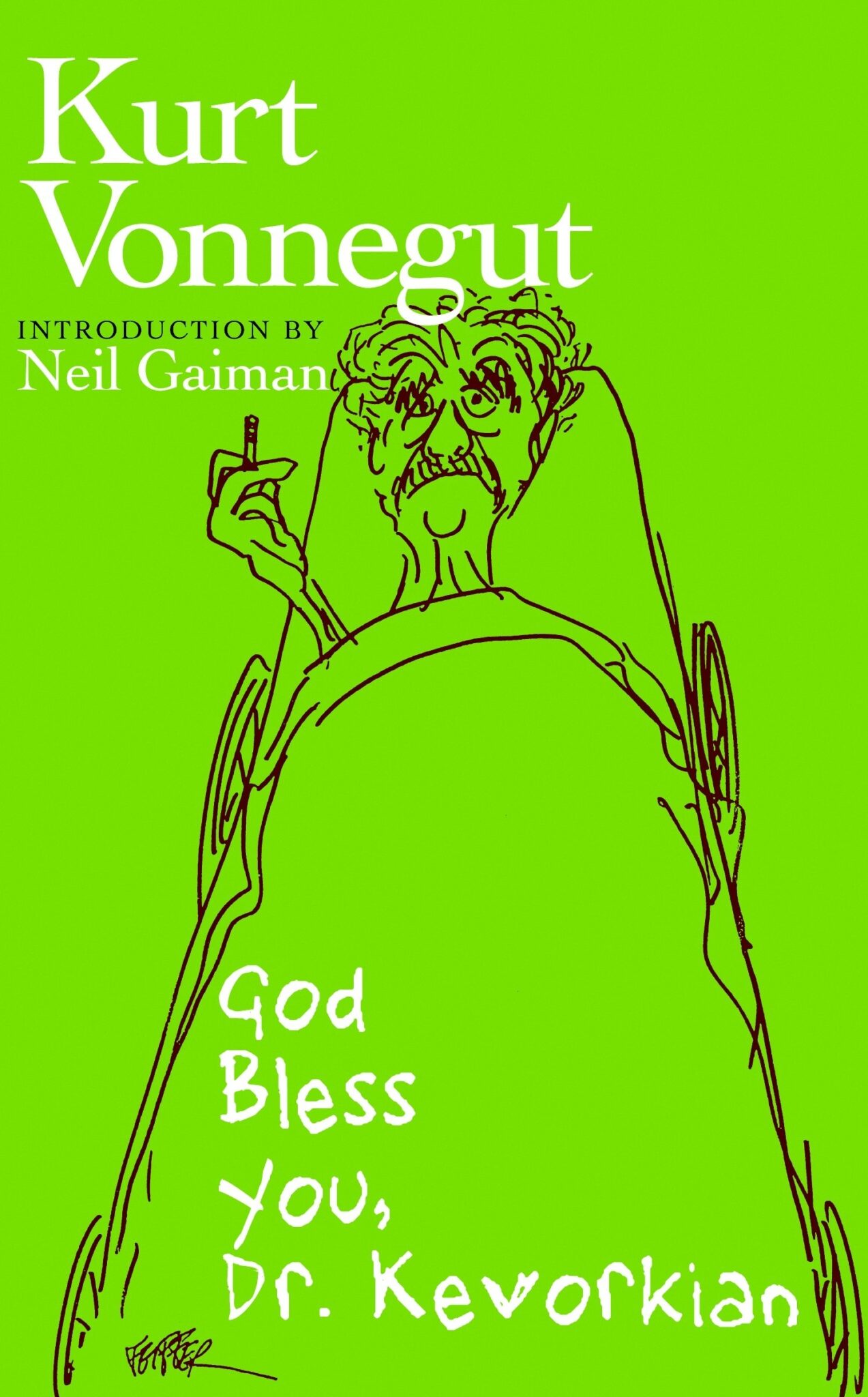 Book Summary: From Slapstick’s “Turkey Farm” to Slaughterhouse-Five’s eternity in a Tralfamadorean zoo cage with Montana Wildhack, the question of the afterlife never left Kurt Vonnegut’s mind. In God Bless You, Dr. Kevorkian, Vonnegut skips back and forth between life and the Afterlife as if the difference between them were rather slight. In thirty odd “interviews,” Vonnegut trips down “the blue tunnel to the pearly gates” in the guise of a roving reporter for public radio, conducting interviews: with Salvatore Biagini, a retired construction worker who died of a heart attack while rescuing his schnauzer from a pit bull, with John Brown, still smoldering 140 years after his death by hanging, with William Shakespeare, who rubs Vonnegut the wrong way, and with socialist and labor leader Eugene Victor Debs, one of Vonnegut’s personal heroes.
Book Summary: From Slapstick’s “Turkey Farm” to Slaughterhouse-Five’s eternity in a Tralfamadorean zoo cage with Montana Wildhack, the question of the afterlife never left Kurt Vonnegut’s mind. In God Bless You, Dr. Kevorkian, Vonnegut skips back and forth between life and the Afterlife as if the difference between them were rather slight. In thirty odd “interviews,” Vonnegut trips down “the blue tunnel to the pearly gates” in the guise of a roving reporter for public radio, conducting interviews: with Salvatore Biagini, a retired construction worker who died of a heart attack while rescuing his schnauzer from a pit bull, with John Brown, still smoldering 140 years after his death by hanging, with William Shakespeare, who rubs Vonnegut the wrong way, and with socialist and labor leader Eugene Victor Debs, one of Vonnegut’s personal heroes.
What began as a series of ninety-second radio interludes for WNYC, New York City’s public radio station, evolved into this provocative collection of musings about who and what we live for, and how much it all matters in the end. From the original portrait by his friend Jules Feiffer that graces the cover, to a final entry from Kilgore Trout, God Bless You, Dr. Kevorkian remains a joy.
- Book Reviews:
30) Bagombo Snuff Box – 1999
 Book Summary: From the acclaimed author of Slaughterhouse-Five, Cat’s Cradle, and Breakfast of Champions comes a compilation of twenty-three never-before-collected short stories.These vignettes of American life draw on Kurt Vonnegut’s World War 2 experiences and the resolute optimism of the country after the war. Together, they present a poignant and humorous portrayal of an America peopled with overzealous high school band directors and their students, rebellious housewives, and boasting salesmen, soldiers misplaced during the war and people lost in their own gadget-filled homes.In an era before television, Kurt Vonnegut found a ready and willing audience in the readers of such magazines as Collier’s, The Saturday Evening Post, Cosmopolitan, Argosy, and Redbook. These rare, rediscovered tales gives us a glimpse into a more innocent America—and into the developing genius of one of the greatest writers of our time.
Book Summary: From the acclaimed author of Slaughterhouse-Five, Cat’s Cradle, and Breakfast of Champions comes a compilation of twenty-three never-before-collected short stories.These vignettes of American life draw on Kurt Vonnegut’s World War 2 experiences and the resolute optimism of the country after the war. Together, they present a poignant and humorous portrayal of an America peopled with overzealous high school band directors and their students, rebellious housewives, and boasting salesmen, soldiers misplaced during the war and people lost in their own gadget-filled homes.In an era before television, Kurt Vonnegut found a ready and willing audience in the readers of such magazines as Collier’s, The Saturday Evening Post, Cosmopolitan, Argosy, and Redbook. These rare, rediscovered tales gives us a glimpse into a more innocent America—and into the developing genius of one of the greatest writers of our time.
- Book Reviews:
31) Like Shaking Hands with God – 1999
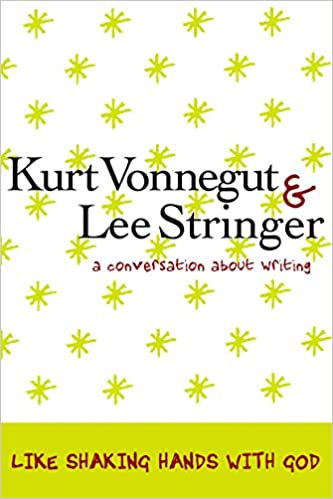 Book Summary: Like Shaking Hands with God details a collaborative journey on the art of writing undertaken by two distinguished writers separated by age, race, upbringing, and education, but sharing common goals and aspirations. Rarely have two writers spoken so candidly about the intersection where the lives they live meet the art they practice. That these two writers happen to be Kurt Vonnegut and Lee Stringer makes this a historic and joyous occasion.
Book Summary: Like Shaking Hands with God details a collaborative journey on the art of writing undertaken by two distinguished writers separated by age, race, upbringing, and education, but sharing common goals and aspirations. Rarely have two writers spoken so candidly about the intersection where the lives they live meet the art they practice. That these two writers happen to be Kurt Vonnegut and Lee Stringer makes this a historic and joyous occasion.
The setting was a bookstore in New York City, the date Thursday, October 1, 1998. Before a crowd of several hundred, Vonnegut and Stringer took up the challenge of writing books that would make a difference and the concomitant challenge of living from day to day. As Vonnegut said afterward, “”It was a magical evening.””
A book for anyone interested in why the simple act of writing things down can be more important than the amount of memory in our computers.
- Book Reviews:
32) Kurt Vonnegut on Mark Twain – 2004
 Book Summary: Vonnegut’s talent for making us laugh, even “at this crisis in our history”, is ubiquitous. His criticisms toward the current war on Iraq are accentuated through the humanity and morality of two great Americans, Mark Twain and Abraham Lincoln. Both “…made the American people laugh at themselves and appreciate really important, really moral jokes.” This propensity for self-awareness resonates all the way through this pamphlet as Vonnegut discusses the present war.
Book Summary: Vonnegut’s talent for making us laugh, even “at this crisis in our history”, is ubiquitous. His criticisms toward the current war on Iraq are accentuated through the humanity and morality of two great Americans, Mark Twain and Abraham Lincoln. Both “…made the American people laugh at themselves and appreciate really important, really moral jokes.” This propensity for self-awareness resonates all the way through this pamphlet as Vonnegut discusses the present war.
- Book Reviews:
33) A Man Without a Country – 2005 (Ninth on Kurt Vonnegut’s Best Book List)
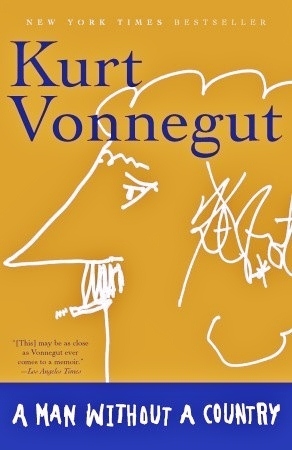 Book Summary: NEW YORK TIMES BESTSELLER • “For all those who have lived with Vonnegut in their imaginations . . . this is what he is like in person.”–USA TodayIn a volume that is penetrating, introspective, incisive, and laugh-out-loud funny, one of the great men of letters of this age–or any age–holds forth on life, art, sex, politics, and the state of America’s soul. From his coming of age in America, to his formative war experiences, to his life as an artist, this is Vonnegut doing what he does best: Being himself. Whimsically illustrated by the author, A Man Without a Country is intimate, tender, and brimming with the scope of Kurt Vonnegut’s passions.Praise for A Man Without a Country“[This] may be as close as Vonnegut ever comes to a memoir.”–Los Angeles Times
Book Summary: NEW YORK TIMES BESTSELLER • “For all those who have lived with Vonnegut in their imaginations . . . this is what he is like in person.”–USA TodayIn a volume that is penetrating, introspective, incisive, and laugh-out-loud funny, one of the great men of letters of this age–or any age–holds forth on life, art, sex, politics, and the state of America’s soul. From his coming of age in America, to his formative war experiences, to his life as an artist, this is Vonnegut doing what he does best: Being himself. Whimsically illustrated by the author, A Man Without a Country is intimate, tender, and brimming with the scope of Kurt Vonnegut’s passions.Praise for A Man Without a Country“[This] may be as close as Vonnegut ever comes to a memoir.”–Los Angeles Times
“Like [that of] his literary ancestor Mark Twain, [Kurt Vonnegut’s] crankiness is good-humored and sharp-witted. . . . [Reading A Man Without a Country is] like sitting down on the couch for a long chat with an old friend.”–The New York Times Book Review
“Filled with [Vonnegut’s] usual contradictory mix of joy and sorrow, hope and despair, humor and gravity.”–Chicago Tribune“Fans will linger on every word . . . as once again [Vonnegut] captures the complexity of the human condition with stunning calligraphic simplicity.”–The Australian“Thank God, Kurt Vonnegut has broken his promise that he will never write another book. In this wondrous assemblage of mini-memoirs, we discover his family’s legacy and his obstinate, unfashionable humanism.”–Studs Terkel
- Book Reviews:
34) Essential Vonnegut Interviews CD Kurt Vonnegut – 2006
 Book Summary: Over the course of Kurt Vonnegut’s career as a writer, he sat down many times with radio host and interviewer Walter James Miller to conduct in-depth discussions of his work and the world. Now Caedmon has collected the best of these interviews on CD for the first time. This is the perfect audio collection for the Vonnegut fan who wants to understand the writer as he was, is, and will be.
Book Summary: Over the course of Kurt Vonnegut’s career as a writer, he sat down many times with radio host and interviewer Walter James Miller to conduct in-depth discussions of his work and the world. Now Caedmon has collected the best of these interviews on CD for the first time. This is the perfect audio collection for the Vonnegut fan who wants to understand the writer as he was, is, and will be.
- Book Reviews:
35) Armageddon in Retrospect – 2008
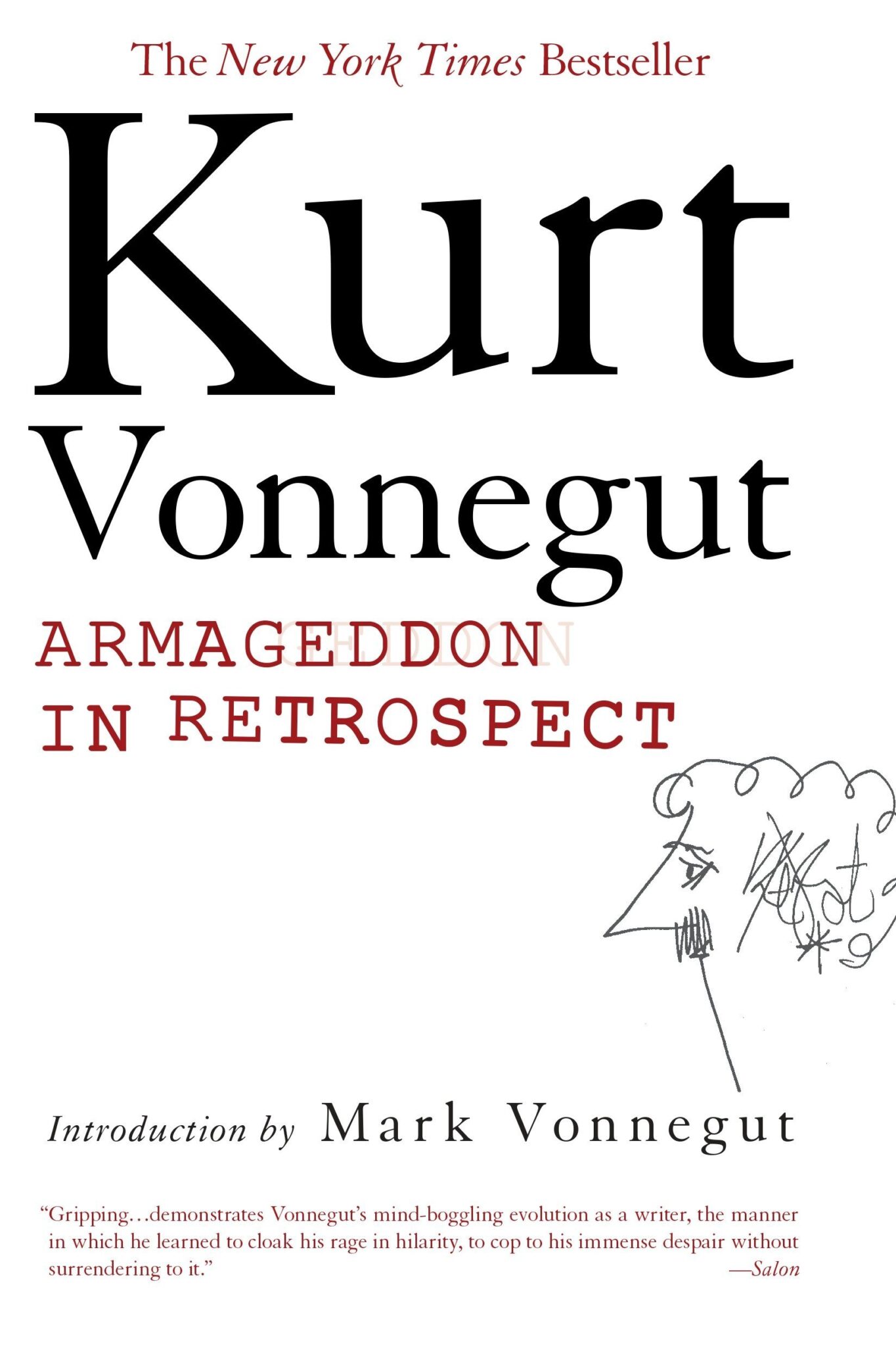 Book Summary: The New York Times bestseller from the author of Slaughterhouse-Five—a “gripping” posthumous collection of Kurt Vonnegut’s previously unpublished work on the subject of war and peace.A fitting tribute to a literary legend and a profoundly humane humorist, Armageddon in Retrospect is a collection of twelve previously unpublished writings. Imbued with Vonnegut’s trademark rueful humor and outraged moral sense, the pieces range from a letter written by Vonnegut to his family in 1945, informing them that he’d been taken prisoner by the Germans, to his last speech, delivered after his death by his son Mark, who provides a warmly personal introduction to the collection. Taken together, these pieces provide fresh insight into Vonnegut’s enduring literary genius and reinforce his ongoing moral relevance in today’s world.Includes an Introduction by Mark Vonnegut
Book Summary: The New York Times bestseller from the author of Slaughterhouse-Five—a “gripping” posthumous collection of Kurt Vonnegut’s previously unpublished work on the subject of war and peace.A fitting tribute to a literary legend and a profoundly humane humorist, Armageddon in Retrospect is a collection of twelve previously unpublished writings. Imbued with Vonnegut’s trademark rueful humor and outraged moral sense, the pieces range from a letter written by Vonnegut to his family in 1945, informing them that he’d been taken prisoner by the Germans, to his last speech, delivered after his death by his son Mark, who provides a warmly personal introduction to the collection. Taken together, these pieces provide fresh insight into Vonnegut’s enduring literary genius and reinforce his ongoing moral relevance in today’s world.Includes an Introduction by Mark Vonnegut
- Book Reviews:
36) Look at the Birdie – 2009
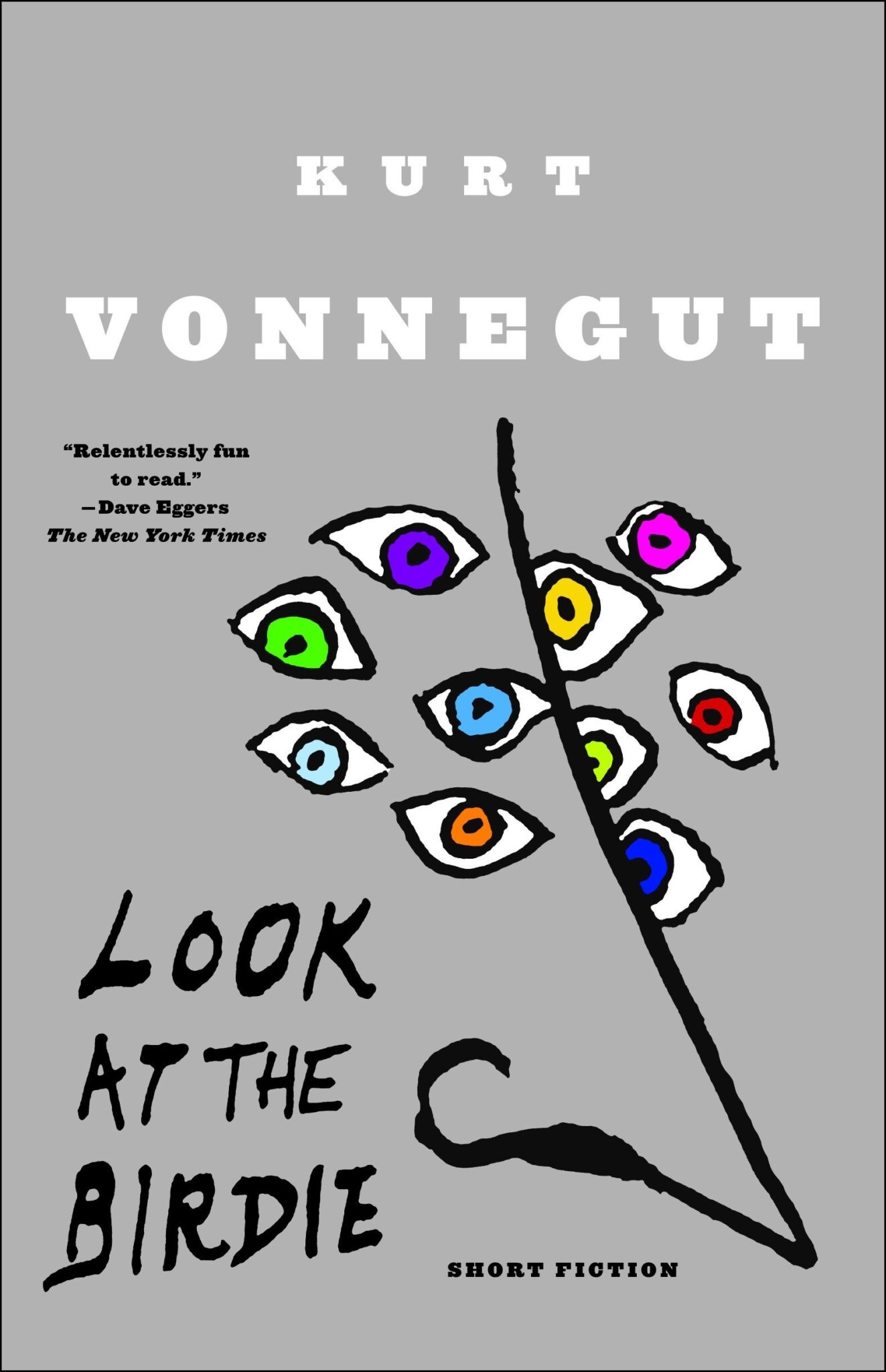 Book Summary: “Relentlessly fun to read.”—Dave Eggers • A collection of fourteen previously unpublished short stories from one of the most original writers in all of American fictionIn this series of perfectly rendered vignettes, written just as he was starting to find his comic voice, Kurt Vonnegut paints a warm, wise, and funny portrait of life in post–World War II America—a world where squabbling couples, high school geniuses, misfit office workers, and small-town lotharios struggle to adapt to changing technology, moral ambiguity, and unprecedented affluence.Here are tales both cautionary and hopeful, each brimming with Vonnegut’s trademark humor and profound humanism. A family learns the downside of confiding their deepest secrets into a magical invention. A man finds himself in a Kafkaesque world of trouble after he runs afoul of the shady underworld boss who calls the shots in an upstate New York town. A quack psychiatrist turned “murder counselor” concocts a novel new outlet for his paranoid patients. While these stories reflect the anxieties of the postwar era that Vonnegut was so adept at capturing—and provide insight into the development of his early style—collectively, they have a timeless quality that makes them just as relevant today as when they were written. It’s impossible to imagine any of these pieces flowing from the pen of another writer; each in its own way is unmistakably, quintessentially Vonnegut.Featuring a foreword by author and longtime Vonnegut confidant Sidney Offit and illustrated with Vonnegut’s characteristically insouciant line drawings, Look at the Birdie is an unexpected gift for readers who thought his unique voice had been stilled forever—and serves as a terrific introduction to his short fiction for anyone who has yet to experience his genius.Includes these never-before-published stories:“Confido”
Book Summary: “Relentlessly fun to read.”—Dave Eggers • A collection of fourteen previously unpublished short stories from one of the most original writers in all of American fictionIn this series of perfectly rendered vignettes, written just as he was starting to find his comic voice, Kurt Vonnegut paints a warm, wise, and funny portrait of life in post–World War II America—a world where squabbling couples, high school geniuses, misfit office workers, and small-town lotharios struggle to adapt to changing technology, moral ambiguity, and unprecedented affluence.Here are tales both cautionary and hopeful, each brimming with Vonnegut’s trademark humor and profound humanism. A family learns the downside of confiding their deepest secrets into a magical invention. A man finds himself in a Kafkaesque world of trouble after he runs afoul of the shady underworld boss who calls the shots in an upstate New York town. A quack psychiatrist turned “murder counselor” concocts a novel new outlet for his paranoid patients. While these stories reflect the anxieties of the postwar era that Vonnegut was so adept at capturing—and provide insight into the development of his early style—collectively, they have a timeless quality that makes them just as relevant today as when they were written. It’s impossible to imagine any of these pieces flowing from the pen of another writer; each in its own way is unmistakably, quintessentially Vonnegut.Featuring a foreword by author and longtime Vonnegut confidant Sidney Offit and illustrated with Vonnegut’s characteristically insouciant line drawings, Look at the Birdie is an unexpected gift for readers who thought his unique voice had been stilled forever—and serves as a terrific introduction to his short fiction for anyone who has yet to experience his genius.Includes these never-before-published stories:“Confido”
“FUBAR”
“Shout About It from the Housetops”
“Ed Luby’s Key Club”
“A Song for Selma”
“Hall of Mirrors”
“The Nice Little People”
“Hello, Red”
“Little Drops of Water”
“The Petrified Ants”
“The Honor of a Newsboy”
“Look at the Birdie”
“King and Queen of the Universe”
“The Good Explainer”“[Look at the Birdie] brings us the late writer’s young voice as he skewers—sometimes gently, always lethally—post World War II America.”—The Boston Globe
- Book Reviews:
37) While Mortals Sleep – 2011
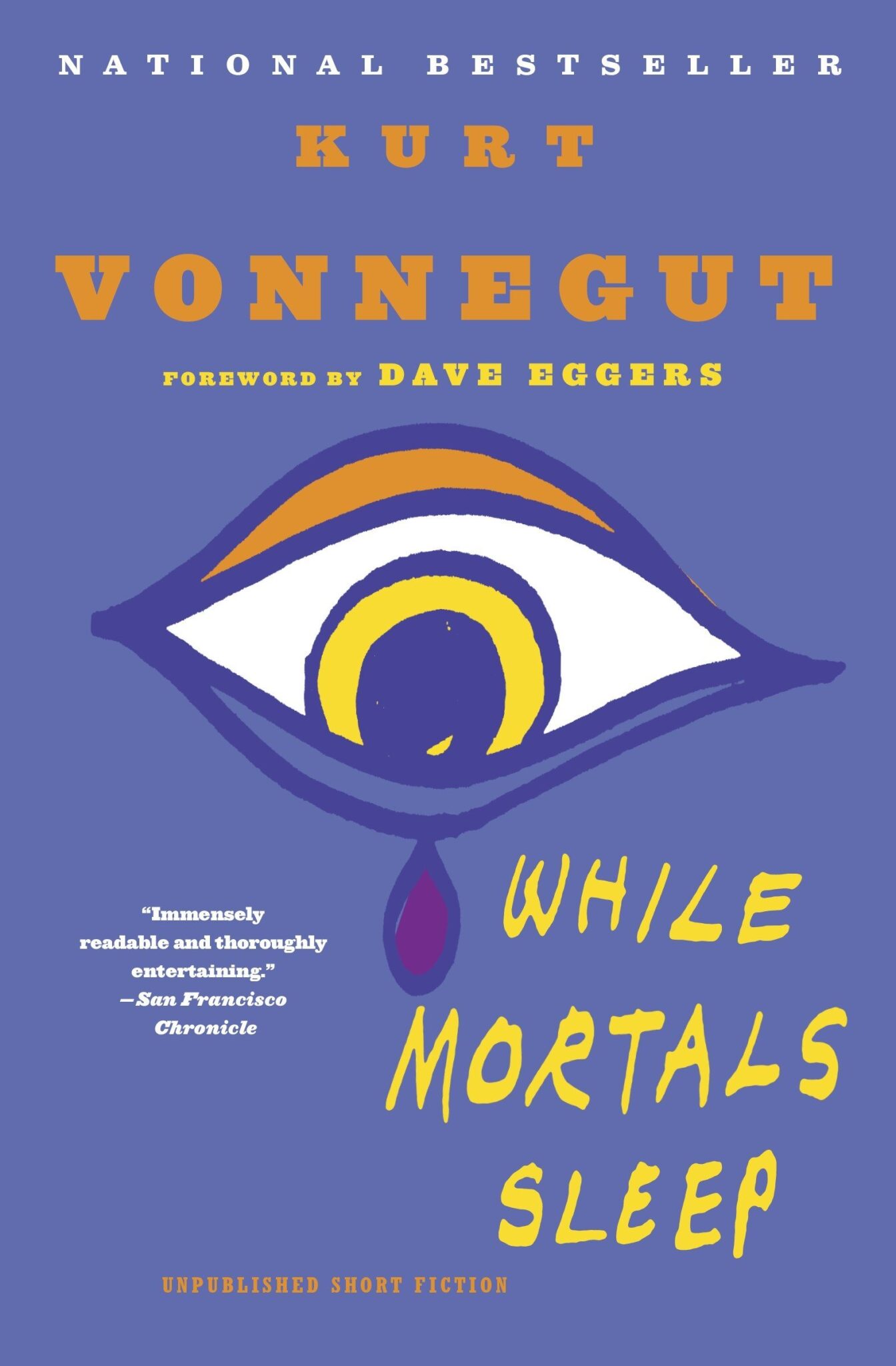 Book Summary: NATIONAL BESTSELLER • Foreword by Dave EggersThese previously unpublished, beautifully rendered works of fiction are a testament to Kurt Vonnegut’s unique blend of observation and imagination. Here are stories of men and machines, art and artifice, and how ideals of fortune, fame, and love take curious twists in ordinary lives.An ambitious builder of roads fritters away his free time with miniature trains—until the women in his life crash his fantasy land. Trapped in a stenography pool, a young dreamer receives a call from a robber on the run, who presents her with a strange proposition. A crusty newspaperman is forced onto a committee to judge Christmas displays—a job that leads him to a suspiciously ostentatious ex-con and then a miracle. Featuring a Foreword by Dave Eggers, While Mortals Sleep is a poignant reflection of our world as it is and as it could be.Includes the following stories:“Jenny”
Book Summary: NATIONAL BESTSELLER • Foreword by Dave EggersThese previously unpublished, beautifully rendered works of fiction are a testament to Kurt Vonnegut’s unique blend of observation and imagination. Here are stories of men and machines, art and artifice, and how ideals of fortune, fame, and love take curious twists in ordinary lives.An ambitious builder of roads fritters away his free time with miniature trains—until the women in his life crash his fantasy land. Trapped in a stenography pool, a young dreamer receives a call from a robber on the run, who presents her with a strange proposition. A crusty newspaperman is forced onto a committee to judge Christmas displays—a job that leads him to a suspiciously ostentatious ex-con and then a miracle. Featuring a Foreword by Dave Eggers, While Mortals Sleep is a poignant reflection of our world as it is and as it could be.Includes the following stories:“Jenny”
“The Epizootic”
“Hundred-Dollar Kisses”
“Guardian of the Person”
“With His Hand on the Throttle”
“Girl Pool”
“Ruth”
“While Mortals Sleep”
“Out, Brief Candle”
“Tango”
“Bomar”
“The Man Without No Kiddleys”
“Mr. Z”
“$10,000 a Year, Easy”
“Money Talks”
“The Humbugs”Praise for While Mortals Sleep“Immensely readable and thoroughly entertaining.”—The Washington Post“Taut, concise . . . The stories set themselves up with neat swiftness, proceed at a clip, and shut down with equal speed, [showing Vonnegut] honing his skills in structure and satire.”—Los Angeles Times“A lovely reminder of the mischievous moral voice we lost when we lost Kurt Vonnegut.”—San Francisco Chronicle
“These stories were all good when they were written decades ago, but many strike me as great now. Never has the voice of Kurt Vonnegut, humanist and humorist, been more relevant.”—The Seattle Times“There’s something distinctly timeless about Vonnegut’s vision.”—Minneapolis Star-Tribune
- Book Reviews:
38) We are what We Pretend to be: The First and Last Works – 2012
- Book Reviews:
39) Kurt Vonnegut: Letters – 2012
 Book Summary: NAMED ONE OF THE BEST BOOKS OF THE YEAR BY
Book Summary: NAMED ONE OF THE BEST BOOKS OF THE YEAR BY
Newsweek/The Daily Beast • The Huffington Post • Kansas City Star • Time Out New York • Kirkus Reviews
This extraordinary collection of personal correspondence has all the hallmarks of Kurt Vonnegut’s fiction. Written over a sixty-year period, these letters, the vast majority of them never before published, are funny, moving, and full of the same uncanny wisdom that has endeared his work to readers worldwide.Included in this comprehensive volume: the letter a twenty-two-year-old Vonnegut wrote home immediately upon being freed from a German POW camp, recounting the ghastly firebombing of Dresden that would be the subject of his masterpiece Slaughterhouse-Five; wry dispatches from Vonnegut’s years as a struggling writer slowly finding an audience and then dealing with sudden international fame in middle age; righteously angry letters of protest to local school boards that tried to ban his work; intimate remembrances penned to high school classmates, fellow veterans, friends, and family; and letters of commiseration and encouragement to such contemporaries as Gail Godwin, Günter Grass, and Bernard Malamud.Vonnegut’s unmediated observations on science, art, and commerce prove to be just as inventive as any found in his novels—from a crackpot scheme for manufacturing “atomic” bow ties to a tongue-in-cheek proposal that publishers be allowed to trade authors like baseball players. (“Knopf, for example, might give John Updike’s contract to Simon and Schuster, and receive Joan Didion’s contract in return.”) Taken together, these letters add considerable depth to our understanding of this one-of-a-kind literary icon, in both his public and private lives. Each letter brims with the mordant humor and openhearted humanism upon which he built his legend. And virtually every page contains a quotable nugget that will make its way into the permanent Vonnegut lexicon.• On a job he had as a young man: “Hell is running an elevator throughout eternity in a building with only six floors.”
• To a relative who calls him a “great literary figure”: “I am an American fad—of a slightly higher order than the hula hoop.”
• To his daughter Nanny: “Most letters from a parent contain a parent’s own lost dreams disguised as good advice.”
• To Norman Mailer: “I am cuter than you are.”Sometimes biting and ironical, sometimes achingly sweet, and always alive with the unique point of view that made him the true cultural heir to Mark Twain, these letters comprise the autobiography Kurt Vonnegut never wrote.Praise for Kurt Vonnegut: Letters“Splendidly assembled . . . familiar, funny, cranky . . . chronicling [Vonnegut’s] life in real time.”—Kurt Andersen, The New York Times Book Review
“[This collection is] by turns hilarious, heartbreaking and mundane. . . . Vonnegut himself is a near-perfect example of the same flawed, wonderful humanity that he loved and despaired over his entire life.”—NPR
“Congenial, whimsical and often insightful missives . . . one of [Vonnegut’s] very best.”—Newsday
“These letters display all the hallmarks of Vonnegut’s fiction—smart, hilarious and heartbreaking.”—The New York Times Book Review
- Book Reviews:
40) If This Isn’t Nice, What Is? Advice for the Young – 2013
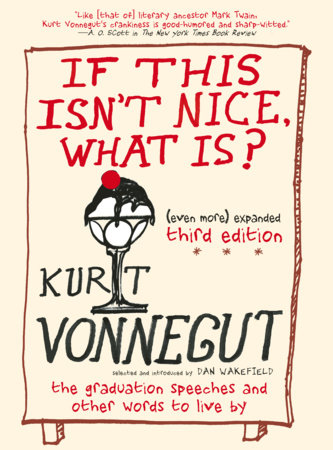 Book Summary: For this first-ever paperback edition of If This Isn’t Nice, What Is?, the beloved collection of Kurt Vonnegut’s campus speeches, editor Dan Wakefield has unearthed three early gems as a sort of prequel—the anti-war Moratorium Day speech he gave in Barnstable, Massachusetts, in October 1969, a 1970 speech to Bennington College recommending “skylarking,” and a 1974 speech to Hobart and William Smith Colleges about the importance of extended families in an age of loneliness.Vonnegut himself never graduated college, so his words of admonition, advice, and hilarity always carried the delight, gentle irony, and generosity of someone savoring the promise of his fellow citizens—especially the young—rather than his own achievements.Selected and introduced by fellow novelist and friend Dan Wakefield, the speeches in If This Isn’t Nice, What Is? comprise the first and only book of Vonnegut’s speeches. There are fourteen speeches, eleven given at colleges, one to the Indiana Civil Liberties Union, one on the occasion of Vonnegut receiving the Carl Sandburg Award, and now the anti-war speech he gave just months after the publication of Slaughterhouse-Five, as well as from related short personal essays—eighteen chapters in all. In each of these, Vonnegut takes pains to find the few things worth saying and a conversational voice to say them in that isn’t heavy-handed or pretentious or glib, but funny, joyful, and serious too, even if sometimes without seeming so.
Book Summary: For this first-ever paperback edition of If This Isn’t Nice, What Is?, the beloved collection of Kurt Vonnegut’s campus speeches, editor Dan Wakefield has unearthed three early gems as a sort of prequel—the anti-war Moratorium Day speech he gave in Barnstable, Massachusetts, in October 1969, a 1970 speech to Bennington College recommending “skylarking,” and a 1974 speech to Hobart and William Smith Colleges about the importance of extended families in an age of loneliness.Vonnegut himself never graduated college, so his words of admonition, advice, and hilarity always carried the delight, gentle irony, and generosity of someone savoring the promise of his fellow citizens—especially the young—rather than his own achievements.Selected and introduced by fellow novelist and friend Dan Wakefield, the speeches in If This Isn’t Nice, What Is? comprise the first and only book of Vonnegut’s speeches. There are fourteen speeches, eleven given at colleges, one to the Indiana Civil Liberties Union, one on the occasion of Vonnegut receiving the Carl Sandburg Award, and now the anti-war speech he gave just months after the publication of Slaughterhouse-Five, as well as from related short personal essays—eighteen chapters in all. In each of these, Vonnegut takes pains to find the few things worth saying and a conversational voice to say them in that isn’t heavy-handed or pretentious or glib, but funny, joyful, and serious too, even if sometimes without seeming so.
- Book Reviews:
41) Sucker’s Portfolio – 2013
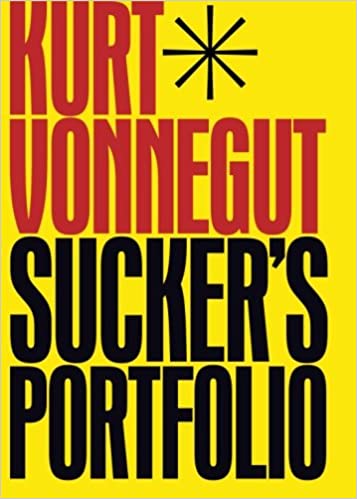 Book Summary: Available to readers for the first time, Sucker’s Portfolio showcases a collection of seven never before published works from Kurt Vonnegut, one of the greatest writers of the 20th century. Short, sardonic, and dark, these six brief fiction stories and one non-fiction piece are consummate Vonnegut with piercing satire and an eye for life’s obscene inanity. Also available for the first time is an unfinished science-fiction short story, included in the appendix.These stories trace trivial human lives and mundane desires, which is precisely where Vonnegut’s inimitable perspective as a humanist shines, illuminating his alternating hopeful and dismal outlook, although undoubtedly focusing on the latter. Here as in his greatest novels, Vonnegut’s writing takes us to the darkest corners of the human soul and with wit and humor, manages to remind us of our potential to be something greater.Episode List
Book Summary: Available to readers for the first time, Sucker’s Portfolio showcases a collection of seven never before published works from Kurt Vonnegut, one of the greatest writers of the 20th century. Short, sardonic, and dark, these six brief fiction stories and one non-fiction piece are consummate Vonnegut with piercing satire and an eye for life’s obscene inanity. Also available for the first time is an unfinished science-fiction short story, included in the appendix.These stories trace trivial human lives and mundane desires, which is precisely where Vonnegut’s inimitable perspective as a humanist shines, illuminating his alternating hopeful and dismal outlook, although undoubtedly focusing on the latter. Here as in his greatest novels, Vonnegut’s writing takes us to the darkest corners of the human soul and with wit and humor, manages to remind us of our potential to be something greater.Episode List
This book was initially released in episodes as a Kindle Serial. All episodes are now available for immediate download as a complete book. Learn more about Kindle Serials
- Book Reviews:
42) Complete Stories – 2017
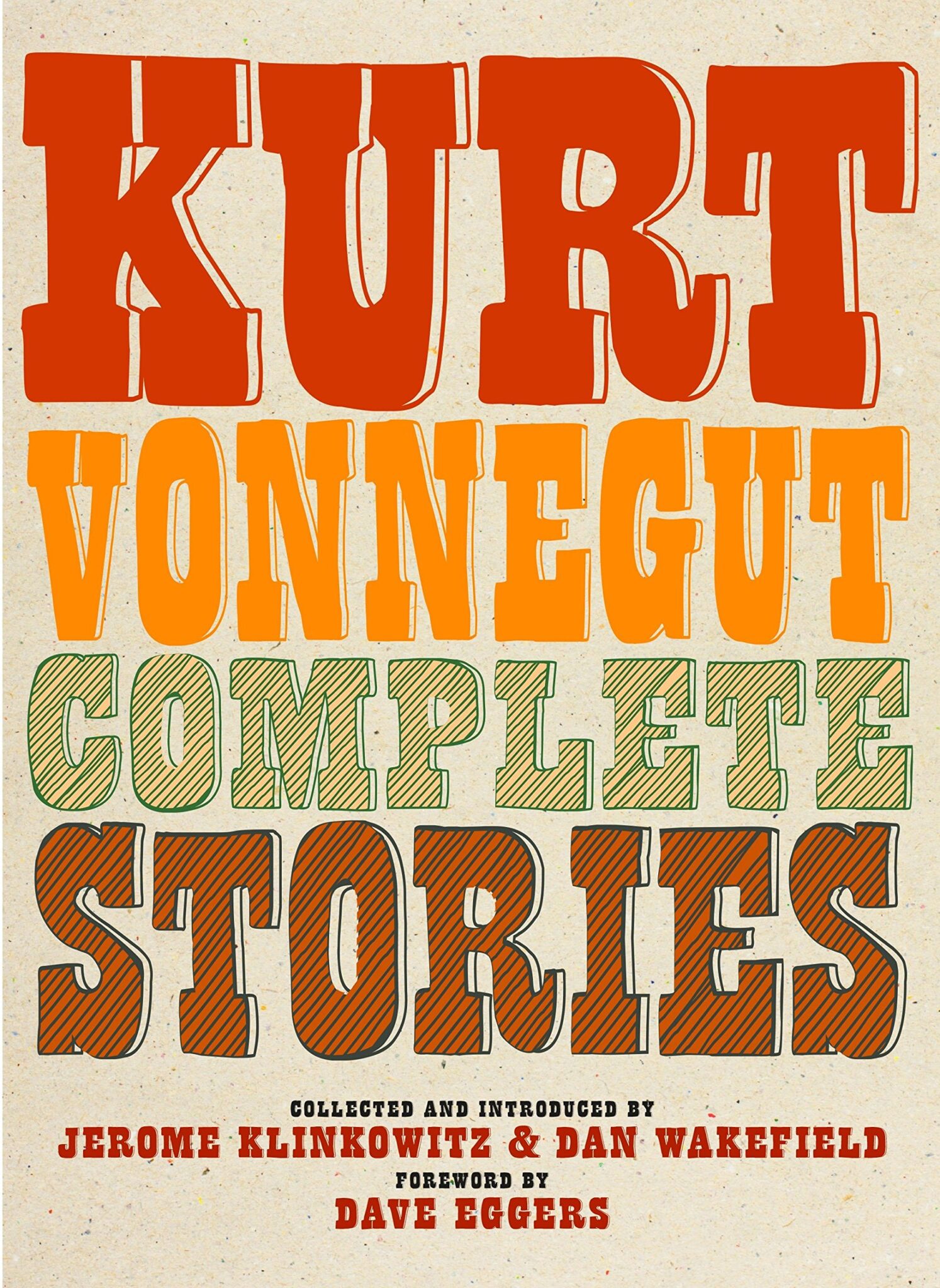 Book Summary: Here for the first time is the complete short fiction of one of the twentieth century’s foremost imaginative geniuses. More than half of Vonnegut’s output was short fiction, and never before has the world had occasion to wrestle with it all together. Organized thematically—”War,” “Women,” “Science,” “Romance,” “Work Ethic versus Fame and Fortune,” “Behavior,” “The Band Director” (those stories featuring Lincoln High’s band director and nice guy George Hemholtz), and “Futuristic”—these ninety-eight stories were written from 1941 to 2007, and include those Vonnegut published in magazines and collected in Welcome to the Monkey House, Bagombo Snuff Box, and other books; here for the first time five previously unpublished stories; as well as a handful of others that were published online and read by few. During his lifetime Vonnegut published fewer than half of the stories he wrote, his agent telling him in 1958 upon the rejection of a particularly strong story, “Save it for the collection of your works which will be published someday when you become famous. Which may take a little time.”Selected and introduced by longtime Vonnegut friends and scholars Dan Wakefield and Jerome Klinkowitz, Complete Stories puts Vonnegut’s great wit, humor, humanity, and artistry on full display. An extraordinary literary feast for new readers, Vonnegut fans, and scholars alike.
Book Summary: Here for the first time is the complete short fiction of one of the twentieth century’s foremost imaginative geniuses. More than half of Vonnegut’s output was short fiction, and never before has the world had occasion to wrestle with it all together. Organized thematically—”War,” “Women,” “Science,” “Romance,” “Work Ethic versus Fame and Fortune,” “Behavior,” “The Band Director” (those stories featuring Lincoln High’s band director and nice guy George Hemholtz), and “Futuristic”—these ninety-eight stories were written from 1941 to 2007, and include those Vonnegut published in magazines and collected in Welcome to the Monkey House, Bagombo Snuff Box, and other books; here for the first time five previously unpublished stories; as well as a handful of others that were published online and read by few. During his lifetime Vonnegut published fewer than half of the stories he wrote, his agent telling him in 1958 upon the rejection of a particularly strong story, “Save it for the collection of your works which will be published someday when you become famous. Which may take a little time.”Selected and introduced by longtime Vonnegut friends and scholars Dan Wakefield and Jerome Klinkowitz, Complete Stories puts Vonnegut’s great wit, humor, humanity, and artistry on full display. An extraordinary literary feast for new readers, Vonnegut fans, and scholars alike.
- Book Reviews:
Conclusion
Did you like these books of Kurt Vonnegut? If you are looking for another author, book series or even genre to read next then check out our collection of must reads here.



